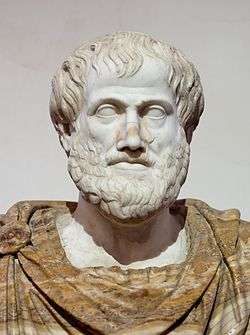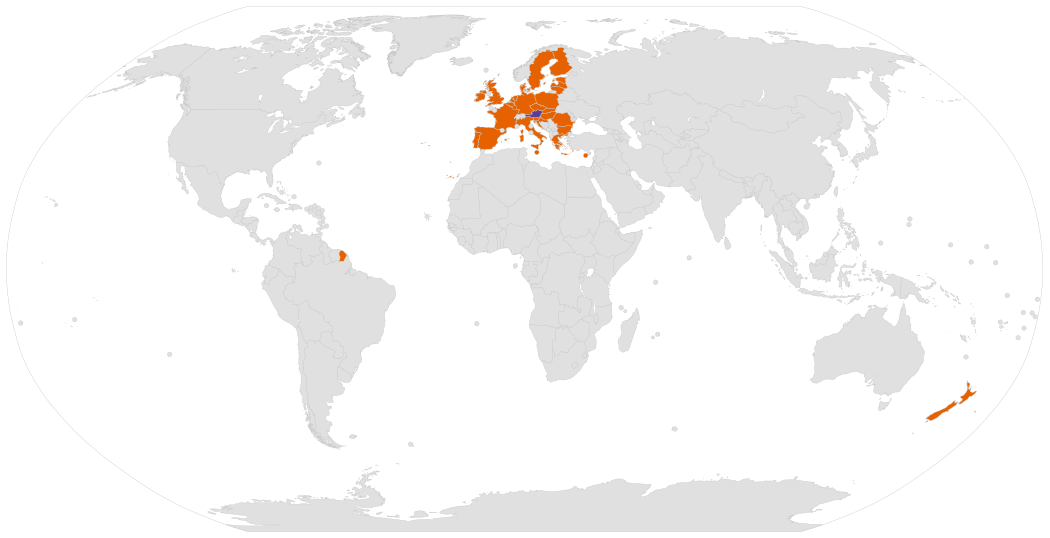Animal rights
Animal rights is the idea in which some, or all, animals are entitled to the possession of their own existence and that their most basic interests—such as the need to avoid suffering—should be afforded the same consideration as similar interests of human beings.[2] That is, some species of animals have the right to be treated as the individuals they are, with their own desires and needs, rather than as unfeeling property.[3]
| Part of a series on |
| Animal rights |
|---|
|
|
Ideas |
|
Related |
|
|
| Rights |
|---|
 |
| Theoretical distinctions |
| Human rights |
| Rights by beneficiary |
| Other groups of rights |

Its advocates oppose the assignment of moral value and fundamental protections on the basis of species membership alone—an idea known since 1970 as speciesism, when the term was coined by Richard D. Ryder—arguing that it is a prejudice as irrational as any other.[4] They maintain that animals should no longer be viewed as property or used as food, clothing, research subjects, entertainment, or beasts of burden.[5] Multiple cultural traditions around the world such as Jainism, Taoism, Hinduism, Buddhism, Shintoism and Animism also espouse some forms of animal rights.
In parallel to the debate about moral rights, animal law is now widely taught in law schools in North America, and several prominent legal scholars, such as Steven M. Wise and Gary L. Francione, support the extension of basic legal rights and personhood to non-human animals. The animals most often considered in arguments for personhood are hominids. This is supported by some animal rights academics because it would break through the species barrier, but opposed by others because it predicates moral value on mental complexity, rather than on sentience alone.[6] As of November 2019, 29 countries have currently enacted bans on hominoid experimentation, and Argentina has granted a captive orangutan basic human rights since 2014.[7]
Critics of animal rights argue that nonhuman animals are unable to enter into a social contract, and thus cannot be possessors of rights, a view summed up by the philosopher Roger Scruton, who writes that only humans have duties, and therefore only humans have rights.[8] Another argument, associated with the utilitarian tradition, is that animals may be used as resources so long as there is no unnecessary suffering;[9] they may have some moral standing, but they are inferior in status to human beings, and any interests they have may be overridden, though what counts as "necessary" suffering or a legitimate sacrifice of interests varies considerably.[10] Certain forms of animal rights activism, such as the destruction of fur farms and animal laboratories by the Animal Liberation Front, have also attracted criticism, including from within the animal rights movement itself,[11] as well as prompted reaction from the U.S. Congress with the enactment of laws allowing these activities to be prosecuted as terrorism, including the Animal Enterprise Terrorism Act.[12]
Historical development in the West
Moral status and animals in the ancient world
Aristotle stated that animals lacked reason (logos), and placed humans at the top of the natural world, yet the respect for animals in ancient Greece was very high. Some animals were considered divine, e.g. dolphins. In the Book of Genesis 1:26 (5th or 6th century BCE), Adam is given "dominion over the fish of the sea, and over the fowl of the air, and over the cattle, and over all the earth, and over every creeping thing that creepeth upon the earth." Dominion need not entail property rights, but it has been interpreted, by some, over the centuries to imply "ownership".[14]
Contemporary philosopher Bernard Rollin writes that "dominion does not entail or allow abuse any more than does dominion a parent enjoys over a child."[15] Rollin further states that the Biblical Sabbath requirement promulgated in the Ten Commandments "required that animals be granted a day of rest along with humans. Correlatively, the Bible forbids 'plowing with an ox and an ass together' (Deut. 22:10–11). According to the rabbinical tradition, this prohibition stems from the hardship that an ass would suffer by being compelled to keep up with an ox, which is, of course, far more powerful. Similarly, one finds the prohibition against 'muzzling an ox when it treads out the grain' (Deut. 25:4–5), and even an environmental prohibition against destroying trees when besieging a city (Deut. 20:19–20). These ancient regulations, virtually forgotten, bespeak of an eloquent awareness of the status of animals as ends in themselves", a point also corroborated by Norm Phelps.[15][16]
The philosopher and mathematician Pythagoras (c. 580–c. 500 BCE) urged respect for animals, believing that human and nonhuman souls were reincarnated from human to animal, and vice versa.[17] Against this, Aristotle (384–322 BCE), student to the philosopher Plato, said that nonhuman animals had no interests of their own, ranking them far below humans in the Great Chain of Being. He was the first to create a taxonomy of animals; he perceived some similarities between humans and other species, but stated for the most part that animals lacked reason (logos), reasoning (logismos), thought (dianoia, nous), and belief (doxa).[13]
Theophrastus (c. 371 – c. 287 BCE), one of Aristotle's pupils, argued that animals also had reasoning (logismos) and opposed eating meat on the grounds that it robbed them of life and was therefore unjust.[18][19] Theophrastus did not prevail; Richard Sorabji writes that current attitudes to animals can be traced to the heirs of the Western Christian tradition selecting the hierarchy that Aristotle sought to preserve.[13]
Plutarch (1 C. CE) in his Life of Cato the Elder comments that while law and justice are applicable strictly to men only, beneficence and charity towards beasts is characteristic of a gentle heart. This is intended as a correction and advance over the merely utilitarian treatment of animals and slaves by Cato himself.[20]
Tom Beauchamp (2011) writes that the most extensive account in antiquity of how animals should be treated was written by the Neoplatonist philosopher Porphyry (234–c. 305 CE), in his On Abstinence from Animal Food, and On Abstinence from Killing Animals.[21]
17th century: Animals as automata
Early animal protection laws in Europe
According to Richard D. Ryder, the first known animal protection legislation in Europe was passed in Ireland in 1635. It prohibited pulling wool off sheep, and the attaching of ploughs to horses' tails, referring to "the cruelty used to beasts."[22] In 1641, the first legal code to protect domestic animals in North America was passed by the Massachusetts Bay Colony.[23] The colony's constitution was based on The Body of Liberties by the Reverend Nathaniel Ward (1578–1652), an English lawyer, Puritan clergyman, and University of Cambridge graduate. Ward's list of "rites" included rite 92: "No man shall exercise any Tirrany or Crueltie toward any brute Creature which are usually kept for man's use." Historian Roderick Nash (1989) writes that, at the height of René Descartes' influence in Europe—and his view that animals were simply automata—it is significant that the New Englanders created a law that implied animals were not unfeeling machines.[24]
The Puritans passed animal protection legislation in England too. Kathleen Kete writes that animal welfare laws were passed in 1654 as part of the ordinances of the Protectorate—the government under Oliver Cromwell (1599–1658), which lasted from 1653 to 1659, following the English Civil War. Cromwell disliked blood sports, which included cockfighting, cock throwing, dog fighting, bull baiting and bull running, said to tenderize the meat. These could be seen in villages and fairgrounds, and became associated with idleness, drunkenness, and gambling. Kete writes that the Puritans interpreted the biblical dominion of man over animals to mean responsible stewardship, rather than ownership. The opposition to blood sports became part of what was seen as Puritan interference in people's lives, and the animal protection laws were overturned during the Restoration, when Charles II was returned to the throne in 1660.[25]
René Descartes
The great influence of the 17th century was the French philosopher René Descartes (1596–1650), whose Meditations (1641) informed attitudes about animals well into the 20th century.[26] Writing during the scientific revolution, Descartes proposed a mechanistic theory of the universe, the aim of which was to show that the world could be mapped out without allusion to subjective experience.[27] His mechanistic approach was extended to the issue of animal consciousness. Mind, for Descartes, was a thing apart from the physical universe, a separate substance, linking human beings to the mind of God. The nonhuman, on the other hand, were for Descartes nothing but complex automata, with no souls, minds, or reason.[26]
Treatment of animals as man's duty towards himself
John Locke, Immanuel Kant
Against Descartes, the British philosopher John Locke (1632–1704) commented, in Some Thoughts Concerning Education (1693), that animals did have feelings, and that unnecessary cruelty toward them was morally wrong, but that the right not to be harmed adhered either to the animal's owner, or to the human being who was being damaged by being cruel. Discussing the importance of preventing children from tormenting animals, he wrote: "For the custom of tormenting and killing of beasts will, by degrees, harden their minds even towards men."[28]
Locke's position echoed that of Thomas Aquinas (1225–1274). Paul Waldau writes that the argument can be found at 1 Corinthians (9:9–10), when Paul asks: "Is it for oxen that God is concerned? Does he not speak entirely for our sake? It was written for our sake." Christian philosophers interpreted this to mean that humans had no direct duty to nonhuman animals, but had a duty only to protect them from the effects of engaging in cruelty.[29]
The German philosopher Immanuel Kant (1724–1804), following Aquinas, opposed the idea that humans have direct duties toward nonhumans. For Kant, cruelty to animals was wrong only because it was bad for humankind. He argued in 1785 that "cruelty to animals is contrary to man's duty to himself, because it deadens in him the feeling of sympathy for their sufferings, and thus a natural tendency that is very useful to morality in relation to other human beings is weakened."[30]
18th century: Centrality of sentience
.jpg)
Jean-Jacques Rousseau
Jean-Jacques Rousseau (1712–1778) argued in Discourse on Inequality (1754) for the inclusion of animals in natural law on the grounds of sentience: "By this method also we put an end to the time-honored disputes concerning the participation of animals in natural law: for it is clear that, being destitute of intelligence and liberty, they cannot recognize that law; as they partake, however, in some measure of our nature, in consequence of the sensibility with which they are endowed, they ought to partake of natural right; so that mankind is subjected to a kind of obligation even toward the brutes. It appears, in fact, that if I am bound to do no injury to my fellow-creatures, this is less because they are rational than because they are sentient beings: and this quality, being common both to men and beasts, ought to entitle the latter at least to the privilege of not being wantonly ill-treated by the former."[31]
In his treatise on education, Emile, or On Education (1762), he encouraged parents to raise their children on a vegetarian diet. He believed that the food of the culture a child was raised eating, played an important role in the character and disposition they would develop as adults. "For however one tries to explain the practice, it is certain that great meat-eaters are usually more cruel and ferocious than other men. This has been recognized at all times and in all places. The English are noted for their cruelty while the Gaures are the gentlest of men. All savages are cruel, and it is not their customs that tend in this direction; their cruelty is the result of their food."
Jeremy Bentham
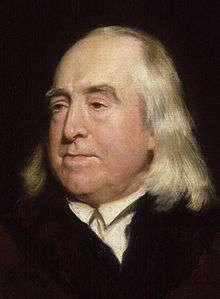
Four years later, one of the founders of modern utilitarianism, the English philosopher Jeremy Bentham (1748–1832), although opposed to the concept of natural rights, argued that it was the ability to suffer that should be the benchmark of how we treat other beings. Bentham states that the capacity for suffering gives the right to equal consideration; equal consideration is that the interests of any being affected by an action are to be considered and have the equal interest of any other being. If rationality were the criterion, he argued, many humans, including infants and the disabled, would also have to be treated as though they were things.[33] He did not conclude that humans and nonhumans had equal moral significance, but argued that the latter's interests should be taken into account. He wrote in 1789, just as African slaves were being freed by the French:
The French have already discovered that the blackness of the skin is no reason a human being should be abandoned without redress to the caprice of a tormentor. It may one day come to be recognized that the number of the legs, the villosity of the skin, or the termination of the os sacrum are reasons equally insufficient for abandoning a sensitive being to the same fate. What else is it that should trace the insuperable line? Is it the faculty of reason or perhaps the faculty of discourse? But a full-grown horse or dog, is beyond comparison a more rational, as well as a more conversable animal, than an infant of a day or a week or even a month, old. But suppose the case were otherwise, what would it avail? the question is not, Can they reason?, nor Can they talk? but, Can they suffer?[34]
19th century: Emergence of jus animalium
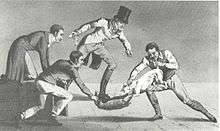
The 19th century saw an explosion of interest in animal protection, particularly in England. Debbie Legge and Simon Brooman write that the educated classes became concerned about attitudes toward the old, the needy, children, and the insane, and that this concern was extended to nonhumans. Before the 19th century, there had been prosecutions for poor treatment of animals, but only because of the damage to the animal as property. In 1793, for example, John Cornish was found not guilty of maiming a horse after pulling the animal's tongue out; the judge ruled that Cornish could be found guilty only if there was evidence of malice toward the owner.[35]
From 1800 onwards, there were several attempts in England to introduce animal protection legislation. The first was a bill against bull baiting, introduced in April 1800 by a Scottish MP, Sir William Pulteney (1729–1805). It was opposed inter alia on the grounds that it was anti-working class, and was defeated by two votes. Another attempt was made in 1802, this time opposed by the Secretary at War, William Windham (1750–1810), who said the Bill was supported by Methodists and Jacobins who wished to "destroy the Old English character, by the abolition of all rural sports."[36]
In 1809, Lord Erskine (1750-1823) introduced a bill to protect cattle and horses from malicious wounding, wanton cruelty, and beating. He told the House of Lords that animals had protection only as property: "The animals themselves are without protection--the law regards them not substantively--they have no rights!"[37] Erskine in his parliamentary speech combined the vocabulary of animal rights and trusteeship with a theological appeal included in the Bill's preamble to opposing cruelty.[38] The Bill was passed by the Lords, but was opposed in the Commons by Windham, who said it would be used against the "lower orders" when the real culprits would be their employers.[36]
Martin's Act
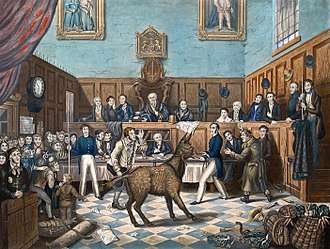
In 1821, the Treatment of Horses bill was introduced by Colonel Richard Martin (1754–1834), MP for Galway in Ireland, but it was lost among laughter in the House of Commons that the next thing would be rights for asses, dogs, and cats.[39] Nicknamed "Humanity Dick" by George IV, Martin finally succeeded in 1822 with his "Ill Treatment of Horses and Cattle Bill"—or "Martin's Act", as it became known—which was the world's first major piece of animal protection legislation. It was given royal assent on June 22 that year as An Act to prevent the cruel and improper Treatment of Cattle, and made it an offence, punishable by fines up to five pounds or two months imprisonment, to "beat, abuse, or ill-treat any horse, mare, gelding, mule, ass, ox, cow, heifer, steer, sheep or other cattle."[35]
Legge and Brooman argue that the success of the Bill lay in the personality of "Humanity Dick", who was able to shrug off the ridicule from the House of Commons, and whose sense of humour managed to capture the House's attention.[35] It was Martin himself who brought the first prosecution under the Act, when he had Bill Burns, a costermonger—a street seller of fruit—arrested for beating a donkey, and paraded the animal's injuries before a reportedly astonished court. Burns was fined, and newspapers and music halls were full of jokes about how Martin had relied on the testimony of a donkey.[40]
Other countries followed suit in passing legislation or making decisions that favoured animals. In 1822, the courts in New York ruled that wanton cruelty to animals was a misdemeanor at common law.[23] In France in 1850, Jacques Philippe Delmas de Grammont succeeded in having the Loi Grammont passed, outlawing cruelty against domestic animals, and leading to years of arguments about whether bulls could be classed as domestic in order to ban bullfighting.[41] The state of Washington followed in 1859, New York in 1866, California in 1868, and Florida in 1889.[42] In England, a series of amendments extended the reach of the 1822 Act, which became the Cruelty to Animals Act 1835, outlawing cockfighting, baiting, and dog fighting, followed by another amendment in 1849, and again in 1876.
Society for the Prevention of Cruelty to Animals
At a meeting of the Society instituted for the purpose of preventing cruelty to animals, on the 16th day of June 1824, at Old Slaughter's Coffee House, St Martin's Lane: T F Buxton Esqr, MP, in the Chair,
It was resolved:
That a committee be appointed to superintend the Publication of Tracts, Sermons, and similar modes of influencing public opinion, to consist of the following Gentlemen:
Sir Jas. Mackintosh MP, A Warre Esqr. MP, Wm. Wilberforce Esqr. MP, Basil Montagu Esqr., Revd. A Broome, Revd. G Bonner, Revd G A Hatch, A E Kendal Esqr., Lewis Gompertz Esqr., Wm. Mudford Esqr., Dr. Henderson.
Resolved also:
That a Committee be appointed to adopt measures for Inspecting the Markets and Streets of the Metropolis, the Slaughter Houses, the conduct of Coachmen, etc.- etc, consisting of the following Gentlemen:
T F Buxton Esqr. MP, Richard Martin Esqr., MP, Sir James Graham, L B Allen Esqr., C C Wilson Esqr., Jno. Brogden Esqr., Alderman Brydges, A E Kendal Esqr., E Lodge Esqr., J Martin Esqr. T G Meymott Esqr.
A. Broome,
Honorary Secretary[40]
Richard Martin soon realized that magistrates did not take the Martin Act seriously, and that it was not being reliably enforced. Martin's Act was supported by various social reformers who were not parliamentarians and an informal network had gathered around the efforts of Reverend Arthur Broome (1779-1837) to create a voluntary organisation that would promote kindness toward animals. Broome canvassed opinions in letters that were published or summarised in various periodicals in 1821.[43] After the passage of Richard Martin's anti-cruelty to cattle bill in 1822, Broome attempted to form a Society for the Prevention of Cruelty to Animals that would bring together the patronage of persons who were of social rank and committed to social reforms. Broome organised and chaired a meeting of sympathisers in November 1822, where it was agreed that a Society should be created and at which Broome was named its Secretary, but the attempt was short-lived.[44] In 1824, Broome arranged a new meeting in Old Slaughter's Coffee House in St Martin's Lane, a London café frequented by artists and actors. The group met on June 16, 1824, and included a number of MPs: Richard Martin, Sir James Mackintosh (1765–1832), Sir Thomas Buxton (1786–1845), William Wilberforce (1759–1833), and Sir James Graham (1792–1861), who had been an MP, and who became one again in 1826.[45]
They decided to form a "Society instituted for the purpose of preventing cruelty to animals"; the Society for the Prevention of Cruelty to Animals, as it became known. It determined to send men to inspect slaughterhouses, Smithfield Market, where livestock had been sold since the 10th century, and to look into the treatment of horses by coachmen.[45] The Society became the Royal Society in 1840, when it was granted a royal charter by Queen Victoria, herself strongly opposed to vivisection.[46]
From 1824 onwards, several books were published, analyzing animal rights issues, rather than protection alone. Lewis Gompertz (1783/4–1865), one of the men who attended the first meeting of the SPCA, published Moral Inquiries on the Situation of Man and of Brutes (1824), arguing that every living creature, human and nonhuman, has more right to the use of its own body than anyone else has to use it, and that our duty to promote happiness applies equally to all beings. Edward Nicholson (1849–1912), head of the Bodleian Library at the University of Oxford, argued in Rights of an Animal (1879) that animals have the same natural right to life and liberty that human beings do, disregarding Descartes' mechanistic view—or what he called the "Neo-Cartesian snake"—that they lack consciousness.[47] Other writers of the time who explored whether animals might have natural (or moral) rights were Edward Payson Evans (1831–1917), John Muir (1838–1914), and J. Howard Moore (1862–1916), an American zoologist and author of The Universal Kinship (1906) and The New Ethics (1907).[48]
Arthur Schopenhauer

The development in England of the concept of animal rights was strongly supported by the German philosopher Arthur Schopenhauer (1788–1860). He wrote that Europeans were "awakening more and more to a sense that beasts have rights, in proportion as the strange notion is being gradually overcome and outgrown, that the animal kingdom came into existence solely for the benefit and pleasure of man."[50]
He stopped short of advocating vegetarianism, arguing that, so long as an animal's death was quick, men would suffer more by not eating meat than animals would suffer by being eaten.[51] Schopenhauer also theorized that the reason people succumbed to the "unnatural diet" of meat-eating was because of the unnatural, cold climate they emigrated to and the necessity of meat for survival in such a climate, for fruits and vegetables could not be dependably cultivated at those times.[52] He applauded the animal protection movement in England—"To the honor, then, of the English, be it said that they are the first people who have, in downright earnest, extended the protecting arm of the law to animals."[50] He also argued against the dominant Kantian idea that animal cruelty is wrong only insofar as it brutalizes humans:
Thus, because Christian morality leaves animals out of account ... they are at once outlawed in philosophical morals; they are mere "things," mere means to any ends whatsoever. They can therefore be used for vivisection, hunting, coursing, bullfights, and horse racing, and can be whipped to death as they struggle along with heavy carts of stone. Shame on such a morality that is worthy of pariahs, chandalas, and mlechchhas, and that fails to recognize the eternal essence that exists in every living thing ...[49]
Percy Bysshe Shelley
The English poet and dramatist Percy Bysshe Shelley (1792–1822) wrote two essays advocating a vegetarian diet, for ethical and health reasons: A Vindication of Natural Diet (1813) and On the Vegetable System of Diet (1829, posth.).
Isabella Beeton
Isabella Beeton (1836-1865) the English reporter, editor and author of Mrs Beeton's Book of Household Management was an early advocate against force-fed poultry and caged hens. About the former, she wrote that force-feeding, was a process that "may produce a handsome-looking bird, and it may weigh enough to satisfy the whim or avarice of its stuffer; but, when before the fire, it will reveal the cruel treatment to which it has been subjected, and will weep a drippingpan-ful of fat tears. You will never find heart enough to place such a grief-worn guest at the head of your table".[53]
About the necessity for free-range rather than caged hens, she wrote:[53]
"We are no advocates for converting the domestic fowl into a cage-bird. We have known amateur fowl-keepers...coop up a male bird and three or four hens in an ordinary egg-chest placed on its side, and with the front closely barred with iron hooping! This system will not do. Every animal, from man himself to the guinea-pig, must have what is vulgarly, but truly, known as “elbow-room;” and it must be self-evident how emphatically this rule applies to winged animals. It may be urged, in the case of domestic fowls, that from constant disuse, and from clipping and plucking, and other sorts of maltreatment, their wings can hardly be regarded as instruments of flight; we maintain, however, that you may pluck a fowl's wing-joints as bare as a pumpkin, but you will not erase from his memory that he is a fowl, and that his proper sphere is the open air. If he likewise reflects that he is an ill-used fowl — a prison-bird — he will then come to the conclusion, that there is not the least use, under such circumstances, for his existence; and you must admit that the decision is only logical and natural."
John Stuart Mill
John Stuart Mill (1806–1873), the English philosopher, also argued that utilitarianism must take animals into account, writing in 1864: "Nothing is more natural to human beings, nor, up to a certain point in cultivation, more universal, than to estimate the pleasures and pains of others as deserving of regard exactly in proportion to their likeness to ourselves. ... Granted that any practice causes more pain to animals than it gives pleasure to man; is that practice moral or immoral? And if, exactly in proportion as human beings raise their heads out of the slough of selfishness, they do not with one voice answer 'immoral,' let the morality of the principle of utility be for ever condemned."[54]
Charles Darwin
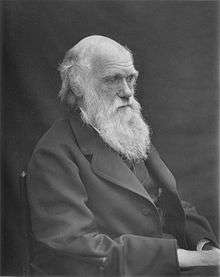
James Rachels writes that Charles Darwin's (1809–1882) On the Origin of Species (1859)—which presented the theory of evolution by natural selection—revolutionized the way humans viewed their relationship with other species. Not only did human beings have a direct kinship with other animals, but the latter had social, mental and moral lives too, Darwin argued.[55] He wrote in his Notebooks (1837): "Animals – whom we have made our slaves we do not like to consider our equals. – Do not slave holders wish to make the black man other kind?"[56] Later, in The Descent of Man (1871), he argued that "There is no fundamental difference between man and the higher mammals in their mental faculties", attributing to animals the power of reason, decision making, memory, sympathy, and imagination.[55]
Rachels writes that Darwin noted the moral implications of the cognitive similarities, arguing that "humanity to the lower animals" was one of the "noblest virtues with which man is endowed." He was strongly opposed to any kind of cruelty to animals, including setting traps. He wrote in a letter that he supported vivisection for "real investigations on physiology; but not for mere damnable and detestable curiosity. It is a subject which makes me sick with horror ..." In 1875, he testified before a Royal Commission on Vivisection, lobbying for a bill to protect both the animals used in vivisection, and the study of physiology. Rachels writes that the animal rights advocates of the day, such as Frances Power Cobbe, did not see Darwin as an ally.[55]
American SPCA, Frances Power Cobbe, Anna Kingsford
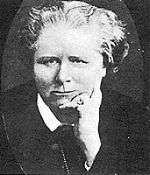
An early proposal for legal rights for animals came from a group of citizens in Ashtabula County, Ohio. Around 1844, the group proposed an amendment to the U.S. Constitution stating that if slaves from slave states were receiving representation as 3/5 of a person on the basis that they were animal property, all the animal property of the free states should receive representation also.[57]
The first animal protection group in the United States, the American Society for the Prevention of Cruelty to Animals (ASPCA), was founded by Henry Bergh in April 1866. Bergh had been appointed by President Abraham Lincoln to a diplomatic post in Russia, and had been disturbed by the mistreatment of animals he witnessed there. He consulted with the president of the RSPCA in London, and returned to the United States to speak out against bullfights, cockfights, and the beating of horses. He created a "Declaration of the Rights of Animals", and in 1866 persuaded the New York state legislature to pass anti-cruelty legislation and to grant the ASPCA the authority to enforce it.[58]
In 1875, the Irish social reformer Frances Power Cobbe (1822–1904) founded the Society for the Protection of Animals Liable to Vivisection, the world's first organization opposed to animal research, which became the National Anti-Vivisection Society. In 1880, the English feminist Anna Kingsford (1846–1888) became one of the first English women to graduate in medicine, after studying for her degree in Paris, and the only student at the time to do so without having experimented on animals. She published The Perfect Way in Diet (1881), advocating vegetarianism, and in the same year founded the Food Reform Society. She was also vocal in her opposition to experimentation on animals.[59] In 1898, Cobbe set up the British Union for the Abolition of Vivisection, with which she campaigned against the use of dogs in research, coming close to success with the 1919 Dogs (Protection) Bill, which almost became law.
Ryder writes that, as the interest in animal protection grew in the late 1890s, attitudes toward animals among scientists began to harden. They embraced the idea that what they saw as anthropomorphism—the attribution of human qualities to nonhumans—was unscientific. Animals had to be approached as physiological entities only, as Ivan Pavlov wrote in 1927, "without any need to resort to fantastic speculations as to the existence of any possible subjective states." It was a position that hearkened back to Descartes in the 17th century, that nonhumans were purely mechanical, with no rationality and perhaps even no consciousness.[60]
Friedrich Nietzsche
Avoiding utilitarianism, Friedrich Nietzsche (1844–1900) found other reasons to defend animals. He wrote that "The sight of blind suffering is the spring of the deepest emotion."[61] He once wrote: "For man is the cruelest animal. At tragedies, bull-fights, and crucifixions hath he hitherto been happiest on earth; and when he invented his hell, behold, that was his heaven on earth."[62] Throughout his writings, he speaks of the human being as an animal.[63]
Henry Salt
In 1894, Henry Salt (1851–1939), a former master at Eton, who had set up the Humanitarian League to lobby for a ban on hunting the year before, published Animals' Rights: Considered in Relation to Social Progress.[64] He wrote that the object of the essay was to "set the principle of animals' rights on a consistent and intelligible footing."[65] Concessions to the demands for jus animalium had been made grudgingly to date, he wrote, with an eye on the interests of animals qua property, rather than as rights bearers:
Even the leading advocates of animal rights seem to have shrunk from basing their claim on the only argument which can ultimately be held to be a really sufficient one—the assertion that animals, as well as men, though, of course, to a far less extent than men, are possessed of a distinctive individuality, and, therefore, are in justice entitled to live their lives with a due measure of that "restricted freedom" to which Herbert Spencer alludes.[65]
He argued that there was no point in claiming rights for animals if those rights were subordinated to human desire, and took issue with the idea that the life of a human might have more moral worth. "[The] notion of the life of an animal having 'no moral purpose,' belongs to a class of ideas which cannot possibly be accepted by the advanced humanitarian thought of the present day—it is a purely arbitrary assumption, at variance with our best instincts, at variance with our best science, and absolutely fatal (if the subject be clearly thought out) to any full realization of animals' rights. If we are ever going to do justice to the lower races, we must get rid of the antiquated notion of a 'great gulf' fixed between them and mankind, and must recognize the common bond of humanity that unites all living beings in one universal brotherhood."[65]
20th century: Animal rights movement
Brown Dog Affair, Lizzy Lind af Hageby
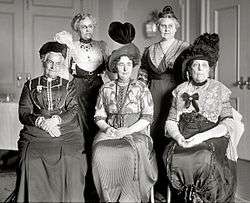
In 1902, Lizzy Lind af Hageby (1878–1963), a Swedish feminist, and a friend, Lisa Shartau, traveled to England to study medicine at the London School of Medicine for Women, intending to learn enough to become authoritative anti-vivisection campaigners. In the course of their studies, they witnessed several animal experiments, and published the details as The Shambles of Science: Extracts from the Diary of Two Students of Physiology (1903). Their allegations included that they had seen a brown terrier dog dissected while conscious, which prompted angry denials from the researcher, William Bayliss, and his colleagues. After Stephen Coleridge of the National Anti-Vivisection Society accused Bayliss of having violated the Cruelty to Animals Act 1876, Bayliss sued and won, convincing a court that the animal had been anesthetized as required by the Act.[66]
In response, anti-vivisection campaigners commissioned a statue of the dog to be erected in Battersea Park in 1906, with the plaque: "Men and Women of England, how long shall these Things be?" The statue caused uproar among medical students, leading to frequent vandalism of the statue and the need for a 24-hour police guard. The affair culminated in riots in 1907 when 1,000 medical students clashed with police, suffragettes and trade unionists in Trafalgar Square. Battersea Council removed the statue from the park under cover of darkness two years later.[66]
Coral Lansbury (1985) and Hilda Kean (1998) write that the significance of the affair lay in the relationships that formed in support of the "Brown Dog Done to Death", which became a symbol of the oppression the women's suffrage movement felt at the hands of the male political and medical establishment. Kean argues that both sides saw themselves as heirs to the future. The students saw the women and trade unionists as representatives of anti-science sentimentality, and the women saw themselves as progressive, with the students and their teachers belonging to a previous age.[67]
Development of veganism
Members of the English Vegetarian Society who avoided the use of eggs and animal milk in the 19th and early 20th century were known as strict vegetarians. The International Vegetarian Union cites an article informing readers of alternatives to shoe leather in the Vegetarian Society's magazine in 1851 as evidence of the existence of a group that sought to avoid animal products entirely. There was increasing unease within the Society from the start of the 20th century onwards with regards to egg and milk consumption, and in 1923 its magazine wrote that the "ideal position for vegetarians is [complete] abstinence from animal products."[68]
Mahatma Gandhi (1869–1948) argued in 1931 before a meeting of the Society in London that vegetarianism should be pursued in the interests of animals, and not only as a human health issue. He met both Henry Salt and Anna Kingsford, and read Salt's A Plea for Vegetarianism (1880). Salt wrote in the pamphlet that "a Vegetarian is still regarded, in ordinary society, as little better than a madman."[68] In 1944, several members, led by Donald Watson (1910–2005), decided to break from the Vegetarian Society over the issue of egg and milk use. Watson coined the term "vegan" for those whose diet included no animal products, and they formed the British Vegan Society on November 1 that year.[69]
Tierschutzgesetz
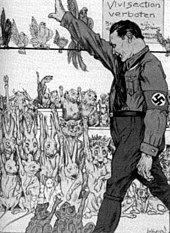
On coming to power in January 1933, the Nazi Party passed a comprehensive set of animal protection laws. Arnold Arluke and Boria Sax wrote that the Nazis tried to abolish the distinction between humans and animals, to the point where many people were regarded as less valuable than animals.[70] In April 1933 the Nazis passed laws regulating the slaughter of animals; one of their targets was kosher slaughter. In November the Tierschutzgesetz, or animal protection law, was introduced, with Adolf Hitler announcing an end to animal cruelty: "Im neuen Reich darf es keine Tierquälerei mehr geben." ("In the new Reich, no more animal cruelty will be allowed.") It was followed in July 1934 by the Reichsjagdgesetz, prohibiting hunting; in July 1935 by the Naturschutzgesetz, environmental legislation; in November 1937 by a law regulating animal transport in cars; and in September 1938 by a similar law dealing with animals on trains.[71] Hitler was a vegetarian in the later years of his life; several members of his inner circle, including Rudolf Hess, Joseph Goebbels, and Heinrich Himmler, adopted some form of vegetarianism. By most accounts their vegetarianism was not as strict as Hitler's.[72]
Increase in animal use
Despite the proliferation of animal protection legislation, animals still had no legal rights. Debbie Legge writes that existing legislation was very much tied to the idea of human interests, whether protecting human sensibilities by outlawing cruelty, or protecting property rights by making sure animals were not harmed. The over-exploitation of fishing stocks, for example, is viewed as harming the environment for people; the hunting of animals to extinction means that humans in the future will derive no enjoyment from them; poaching results in financial loss to the owner, and so on.[42]
Notwithstanding the interest in animal welfare of the previous century, the situation for animals deteriorated in the 20th century, particularly after the Second World War. This was in part because of the increase in the numbers used in animal research—300 in the UK in 1875, 19,084 in 1903, and 2.8 million in 2005 (50–100 million worldwide), and a modern annual estimated range of 10 million to upwards of 100 million in the US[73]—but mostly because of the industrialization of farming, which saw billions of animals raised and killed for food on a scale considered impossible before the war.[74]
Development of direct action
In the early 1960s in England, support for animal rights began to coalesce around the issue of blood sports, particularly hunting deer, foxes, and otters using dogs, an aristocratic and middle-class English practice, stoutly defended in the name of protecting rural traditions. The psychologist Richard D. Ryder – who became involved with the animal rights movement in the late 1960s – writes that the new chair of the League Against Cruel Sports tried in 1963 to steer it away from confronting members of the hunt, which triggered the formation that year of a direct action breakaway group, the Hunt Saboteurs Association. This was set up by a journalist, John Prestige, who had witnessed a pregnant deer being chased into a village and killed by the Devon and Somerset Staghounds. The practice of sabotaging hunts (for example, by misleading the dogs with scents or horns) spread throughout south-east England, particularly around university towns, leading to violent confrontations when the huntsmen attacked the "sabs".[75]
The controversy spread to the RSPCA, which had grown away from its radical roots to become a conservative group with charity status and royal patronage. It had failed to speak out against hunting, and indeed counted huntsmen among its members. As with the League Against Cruel Sports, this position gave rise to a splinter group, the RSPCA Reform Group, which sought to radicalize the organization, leading to chaotic meetings of the group's ruling Council, and successful (though short-lived) efforts to change it from within by electing to the Council members who would argue from an animal rights perspective, and force the RSPCA to address issues such as hunting, factory farming, and animal experimentation. Ryder himself was elected to the Council in 1971, and served as its chair from 1977 to 1979.[75]
Formation of the Oxford group
The same period saw writers and academics begin to speak out again in favor of animal rights. Ruth Harrison published Animal Machines (1964), an influential critique of factory farming, and on October 10, 1965, the novelist Brigid Brophy had an article, "The Rights of Animals", published in The Sunday Times.[60] She wrote:
The relationship of homo sapiens to the other animals is one of unremitting exploitation. We employ their work; we eat and wear them. We exploit them to serve our superstitions: whereas we used to sacrifice them to our gods and tear out their entrails in order to foresee the future, we now sacrifice them to science, and experiment on their entrails in the hope—or on the mere off chance—that we might thereby see a little more clearly into the present ... To us it seems incredible that the Greek philosophers should have scanned so deeply into right and wrong and yet never noticed the immorality of slavery. Perhaps 3000 years from now it will seem equally incredible that we do not notice the immorality of our own oppression of animals.[60]
Robert Garner writes that Harrison's book and Brophy's article led to an explosion of interest in the relationship between humans and nonhumans.[76] In particular, Brophy's article was discovered in or around 1969 by a group of postgraduate philosophy students at the University of Oxford, Roslind and Stanley Godlovitch (husband and wife from Canada), John Harris, and David Wood, now known as the Oxford Group. They decided to put together a symposium to discuss the theory of animal rights.[60]
Around the same time, Richard Ryder wrote several letters to The Daily Telegraph criticizing animal experimentation, based on incidents he had witnessed in laboratories. The letters, published in April and May 1969, were seen by Brigid Brophy, who put Ryder in touch with the Godlovitches and Harris. Ryder also started distributing pamphlets in Oxford protesting against experiments on animals; it was in one of these pamphlets in 1970 that he coined the term "speciesism" to describe the exclusion of nonhuman animals from the protections offered to humans.[77] He subsequently became a contributor to the Godlovitches' symposium, as did Harrison and Brophy, and it was published in 1971 as Animals, Men and Morals: An Inquiry into the Maltreatment of Non-humans.[78]
Publication of Animal Liberation
In 1970, over lunch in Oxford with fellow student Richard Keshen, a vegetarian, Australian philosopher Peter Singer came to believe that, by eating animals, he was engaging in the oppression of other species. Keshen introduced Singer to the Godlovitches, and in 1973 Singer reviewed their book for The New York Review of Books. In the review, he used the term "animal liberation", writing:
We are familiar with Black Liberation, Gay Liberation, and a variety of other movements. With Women's Liberation some thought we had come to the end of the road. Discrimination on the basis of sex, it has been said, is the last form of discrimination that is universally accepted and practiced without pretense ... But one should always be wary of talking of "the last remaining form of discrimination." ... Animals, Men and Morals is a manifesto for an Animal Liberation movement.[79]
Singer pointed out that claiming animal rights in particular has nothing to do with "animal affection." Just as claiming race or gender equality does not mean that they are "black lovers" or "female lovers," they say, "there is no reason to assume that those who strive to improve animal conditions should love animals." You can do it or don't have to do it because it's your taste. However, the issue of rights is not the realm of likes and dislikes, but the realm of party. This argument spread throughout American society the discussion of animal rights, which was then only among "animal lovers."[80]
On the strength of his review, The New York Review of Books took the unusual step of commissioning a book from Singer on the subject, published in 1975 as Animal Liberation, now one of the animal rights movement's canonical texts. Singer based his arguments on the principle of utilitarianism – the view, in its simplest form, that an act is right if it leads to the "greatest happiness of the greatest number", a phrase first used in 1776 by Jeremy Bentham.[79] He argued in favor of the equal consideration of interests, the position that there are no grounds to suppose that a violation of the basic interests of a human—for example, an interest in not suffering—is different in any morally significant way from a violation of the basic interests of a nonhuman.[81] Singer used the term "speciesism" in the book, citing Ryder, and it stuck, becoming an entry in the Oxford English Dictionary in 1989.[82]
The book's publication triggered a groundswell of scholarly interest in animal rights. Richard Ryder's Victims of Science: The Use of Animals in Research (1975) appeared, followed by Andrew Linzey's Animal Rights: A Christian Perspective (1976), and Stephen R. L. Clark's The Moral Status of Animals (1977). A Conference on Animal Rights was organized by Ryder and Linzey at Trinity College, Cambridge, in August 1977. This was followed by Mary Midgley's Beast And Man: The Roots of Human Nature (1978), then Animal Rights–A Symposium (1979), which included the papers delivered to the Cambridge conference.[76]
From 1982 onwards, a series of articles by Tom Regan led to his The Case for Animal Rights (1984), in which he argues that nonhuman animals are "subjects-of-a-life", and therefore possessors of moral rights, a work regarded as a key text in animal rights theory.[76] Regan wrote in 2001 that philosophers had written more about animal rights in the previous 20 years than in the 2,000 years before that.[83] Garner writes that Charles Magel's bibliography, Keyguide to Information Sources in Animal Rights (1989), contains 10 pages of philosophical material on animals up to 1970, but 13 pages between 1970 and 1989 alone.[84]
Founding of the Animal Liberation Front
In 1971, a law student, Ronnie Lee, formed a branch of the Hunt Saboteurs Association in Luton, later calling it the Band of Mercy after a 19th-century RSPCA youth group. The Band attacked hunters' vehicles by slashing tires and breaking windows, calling it "active compassion". In November 1973, they engaged in their first act of arson when they set fire to a Hoechst Pharmaceuticals research laboratory, claiming responsibility as a "nonviolent guerilla organization dedicated to the liberation of animals from all forms of cruelty and persecution at the hands of mankind."[85]
Lee and another activist were sentenced to three years in prison in 1974, paroled after 12 months. In 1976, Lee brought together the remaining Band of Mercy activists along with some fresh faces to start a leaderless resistance movement, calling it the Animal Liberation Front (ALF).[85] ALF activists see themselves as a modern Underground Railroad, passing animals removed from farms and laboratories to sympathetic veterinarians, safe houses and sanctuaries.[86] Some activists also engage in threats, intimidation, and arson, acts that have lost the movement sympathy in mainstream public opinion.[87]
The decentralized model of activism is frustrating for law enforcement organizations, who find the networks difficult to infiltrate, because they tend to be organized around friends.[88] In 2005, the US Department of Homeland Security indicated how seriously it takes the ALF when it included them in a list of domestic terrorist threats.[89] The tactics of some of the more determined ALF activists are anathema to many animal rights advocates, such as Singer, who regard the movement as something that should occupy the moral high ground. ALF activists respond to the criticism with the argument that, as Ingrid Newkirk puts it, "Thinkers may prepare revolutions, but bandits must carry them out."[90]
From the 1980s through to the early 2000s there was an increased level of violence by animal rights extremist groups directed at individuals and institutions associated with animal research. Activist groups involved included the Justice Department, the Animal Rights Militia and SHAC.[91]
Subcultures and animal rights
In the 1980s, animal rights became associated with punk subculture and ideologies, particularly straight edge hardcore punk in the United States[92][93] and anarcho-punk in the United Kingdom.[94] This association continues on into the 21st century, as evidenced by the prominence of vegan punk events such as Fluff Fest in Europe.[95]
Animal Rights International
Henry Spira (1927–1998), a former seaman and civil rights activist, became the most notable of the new animal advocates in the United States. A proponent of gradual change, he formed Animal Rights International in 1974, and introduced the idea of "reintegrative shaming", whereby a relationship is formed between a group of animal rights advocates and a corporation they see as misusing animals, with a view to obtaining concessions or halting a practice. It is a strategy that has been widely adopted, including the group People for the Ethical Treatment of Animals.[96]
Spira's first campaign was in opposition to the American Museum of Natural History in 1976, where cats were being experimented on, research that he persuaded them to stop. In 1980 he convinced the cosmetics company Revlon to stop using the Draize test, which involves toxicity tests on the skin or in the eyes of animals. He took out a full-page ad in several newspapers, featuring a rabbit with sticking plaster over the eyes, and the caption, "How many rabbits does Revlon blind for beauty's sake?" Revlon stopped using animals for cosmetics testing, donated money to help set up the Center for Alternatives to Animal Testing, and was followed by other leading cosmetics companies.[97]
21st century: developments
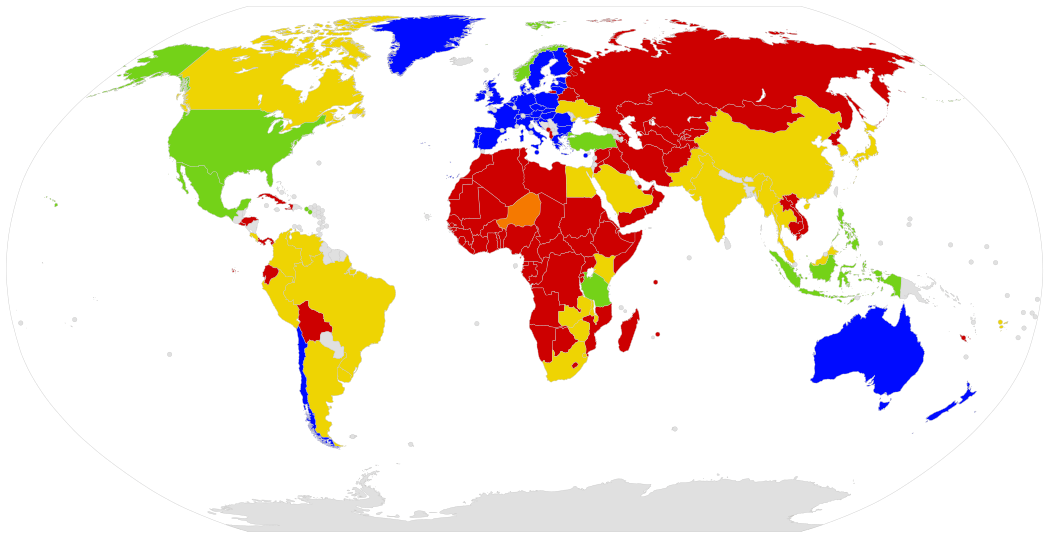
| | National recognition of animal sentience | | Partial recognition of animal sentience1 |
| | National recognition of animal suffering | | Partial recognition of animal suffering2 |
| | No official recognition of animal sentience or suffering | | Unknown |
2only includes domestic animals
In 1999, New Zealand passed a new Animal Welfare Act that had the effect of banning experiments on "non-human hominids".[98]
Also in 1999, Public Law 106-152 (Title 18, Section 48) was put into action in the United States. This law makes it a felony to create, sell, or possess videos showing animal cruelty with the intention of profiting financially from them.[99]
In 2005, the Austrian Parliament banned experiments on apes, unless they are performed in the interests of the individual ape.[98] Also in Austria, the Supreme Court ruled in January 2008 that a chimpanzee (called Matthew Hiasl Pan by those advocating for his personhood) was not a person, after the Association Against Animal Factories sought personhood status for him because his custodians had gone bankrupt. The chimpanzee had been captured as a baby in Sierra Leone in 1982, then smuggled to Austria to be used in pharmaceutical experiments, but was discovered by customs officials when he arrived in the country, and was taken to a shelter instead. He was kept there for 25 years, until the group that ran the shelter went bankrupt in 2007. Donors offered to help him, but under Austrian law only a person can receive personal gifts, so any money sent to support him would be lost to the shelter's bankruptcy. The Association appealed the ruling to the European Court of Human Rights. The lawyer proposing the chimpanzee's personhood asked the court to appoint a legal guardian for him and to grant him four rights: the right to life, limited freedom of movement, personal safety, and the right to claim property.[100][101][102]
In June 2008, a committee of Spain's national legislature became the first to vote for a resolution to extend limited rights to nonhuman primates. The parliamentary Environment Committee recommended giving chimpanzees, bonobos, gorillas and orangutans the right not to be used in medical experiments or in circuses, and recommended making it illegal to kill apes, except in self-defense, based upon the rights recommended by the Great Ape Project.[103][104][105][106][107][108] The committee's proposal has not yet been enacted into law.[109]
From 2009 onwards, several countries outlawed the use of some or all animals in circuses, starting with Bolivia, and followed by several countries in Europe, Scandinavia, the Middle East, and Singapore.[110][103]
In 2010, the regional government in Catalonia passed a motion to outlaw bull fighting, the first such ban in Spain.[111] In 2011, PETA sued SeaWorld over the captivity of five orcas in San Diego and Orlando, arguing that the whales were being treated as slaves. It was the first time the Thirteenth Amendment to the United States Constitution, which outlaws slavery and involuntary servitude, was cited in court to protect nonhuman rights. A federal judge dismissed the case in February 2012.[112][113]
Petitions for habeas corpus
In 2015, the Nonhuman Rights Project (NhPR) filed three lawsuits in New York State on behalf of four captive chimpanzees, demanding that the courts grant them the right to bodily liberty via the writ of habeas corpus and immediately send them to a sanctuary affiliated with the North American Primate Sanctuary Alliance.[114] All of the petitions were denied. In the case involving the chimpanzees Hercules and Leo, Justice Barbara Jaffe did not immediately dismiss the filing and instead ordered a hearing requiring the chimpanzee owner to show why the chimpanzees should not be released and transferred to the sanctuary.[115] Following the hearing, Justice Jaffe issued an order denying Hercules and Leo's petition.
Even though the petition was denied, the NhRP interpreted Justice Jaffe's decision as a victory. In its press release it emphasized the fact that Justice Jaffe agreed with NhRP, writing that "'persons' are not restricted to human beings, and that who is a 'person' is not a question of biology, but of public policy and principle" and also stating that "efforts to extend legal rights to chimpanzees are thus understandable; some day they may even succeed."[116]
In East and South Asia
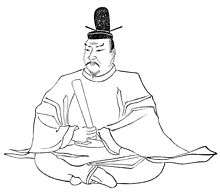

The belief in and promotion of animal rights has had a long history in East and South Asia. It has its roots in traditional Eastern religious and philosophical beliefs and concepts such as ahimsa, the doctrine of non-violence.
Ancient era
Several kings in India built hospitals for animals, and the emperor Ashoka (304–232 BCE) issued orders against hunting and animal slaughter, in line with ahimsa, the doctrine of non-violence.[117]
In Japan in 675, the Emperor Tenmu prohibited the killing and the eating of meat during the busy farming period between April and September but excluded the eating of wild birds and animals. This ban and several others that followed over the centuries were overturned in the nineteenth century during the Meiji restoration.[118]
Modern era
In 2000, the High Court in Kerala, India used the language of "rights" in relation to circus animals, ruling that they are "beings entitled to dignified existence" under Article 21 of the Indian Constitution. The ruling said that if human beings are entitled to these rights, animals should be too. The court went beyond the requirements of the Constitution that all living beings should be shown compassion, and said: "It is not only our fundamental duty to show compassion to our animal friends, but also to recognize and protect their rights." Waldau wrote that other courts in India and one court in Sri Lanka have used similar language.[98]
In 2012, the Indian government issued a ban on the use of live animals in education and much research.[119]
In 2014, the Jain pilgrimage destination of Palitana City in India became the first city in the world to be legally vegetarian. It has outlawed, or made illegal, the buying and selling of meat, fish and eggs, and also related jobs or work, such as fishing and penning 'food animals'.[120]
In religion
For some the basis of animal rights is in religion or animal worship (or in general nature worship), with some religions banning killing of any animal, and in other religions animals can be considered unclean.
Hindu and Buddhist societies abandoned animal sacrifice and embraced vegetarianism from the 3rd century BCE. [121] One of the most important sanctions of the Jain, Hindu and Buddhist faiths is the concept of ahimsa, or refraining from the destruction of life. According to Buddhist belief, humans do not deserve preferential treatment over other living beings.[122] The Dharmic interpretation of this doctrine prohibits the killing of any living being.[122]
In Islam, animal rights were recognized early by the Sharia. This recognition is based on both the Qur'an and the Hadith. In the Qur'an, there are many references to animals, detailing that they have souls, form communities, communicate with God and worship Him in their own way. Muhammad forbade his followers to harm any animal and asked them to respect the rights of animals.[123]
Philosophical and legal approaches
Overview

The two main philosophical approaches to animal rights are utilitarian and rights-based. The former is exemplified by Peter Singer, and the latter by Tom Regan and Gary Francione. Their differences reflect a distinction philosophers draw between ethical theories that judge the rightness of an act by its consequences (consequentialism/teleological ethics, or utilitarianism), and those that focus on the principle behind the act, almost regardless of consequences (deontological ethics). Deontologists argue that there are acts we should never perform, even if failing to do so entails a worse outcome.[124]
There are a number of positions that can be defended from a consequentalist or deontologist perspective, including the capabilities approach, represented by Martha Nussbaum, and the egalitarian approach, which has been examined by Ingmar Persson and Peter Vallentyne. The capabilities approach focuses on what individuals require to fulfill their capabilities: Nussbaum (2006) argues that animals need a right to life, some control over their environment, company, play, and physical health.[125]
Stephen R. L. Clark, Mary Midgley, and Bernard Rollin also discuss animal rights in terms of animals being permitted to lead a life appropriate for their kind.[126] Egalitarianism favors an equal distribution of happiness among all individuals, which makes the interests of the worse off more important than those of the better off.[127] Another approach, virtue ethics, holds that in considering how to act we should consider the character of the actor, and what kind of moral agents we should be. Rosalind Hursthouse has suggested an approach to animal rights based on virtue ethics.[128] Mark Rowlands has proposed a contractarian approach.[129]
Utilitarianism
Nussbaum (2004) writes that utilitarianism, starting with Jeremy Bentham and John Stuart Mill, has contributed more to the recognition of the moral status of animals than any other ethical theory.[130] The utilitarian philosopher most associated with animal rights is Peter Singer, professor of bioethics at Princeton University. Singer is not a rights theorist, but uses the language of rights to discuss how we ought to treat individuals. He is a preference utilitarian, meaning that he judges the rightness of an act by the extent to which it satisfies the preferences (interests) of those affected.[131]
His position is that there is no reason not to give equal consideration to the interests of human and nonhumans, though his principle of equality does not require identical treatment. A mouse and a man both have an interest in not being kicked, and there are no moral or logical grounds for failing to accord those interests equal weight. Interests are predicated on the ability to suffer, nothing more, and once it is established that a being has interests, those interests must be given equal consideration.[132] Singer quotes the English philosopher Henry Sidgwick (1838–1900): "The good of any one individual is of no more importance, from the point of view ... of the Universe, than the good of any other."[81]
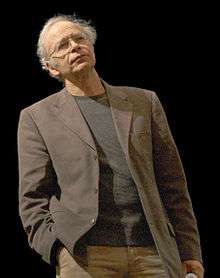
Singer argues that equality of consideration is a prescription, not an assertion of fact: if the equality of the sexes were based only on the idea that men and women were equally intelligent, we would have to abandon the practice of equal consideration if this were later found to be false. But the moral idea of equality does not depend on matters of fact such as intelligence, physical strength, or moral capacity. Equality therefore cannot be grounded on the outcome of scientific investigations into the intelligence of nonhumans. All that matters is whether they can suffer.[133]
Commentators on all sides of the debate now accept that animals suffer and feel pain, although it was not always so. Bernard Rollin, professor of philosophy, animal sciences, and biomedical sciences at Colorado State University, writes that Descartes' influence continued to be felt until the 1980s. Veterinarians trained in the US before 1989 were taught to ignore pain, he writes, and at least one major veterinary hospital in the 1960s did not stock narcotic analgesics for animal pain control. In his interactions with scientists, he was often asked to "prove" that animals are conscious, and to provide "scientifically acceptable" evidence that they could feel pain.[134]
Scientific publications have made it clear since the 1980s that the majority of researchers do believe animals suffer and feel pain, though it continues to be argued that their suffering may be reduced by an inability to experience the same dread of anticipation as humans, or to remember the suffering as vividly.[135] The problem of animal suffering, and animal consciousness in general, arose primarily because it was argued that animals have no language. Singer writes that, if language were needed to communicate pain, it would often be impossible to know when humans are in pain, though we can observe pain behavior and make a calculated guess based on it. He argues that there is no reason to suppose that the pain behavior of nonhumans would have a different meaning from the pain behavior of humans.[136]
Subjects-of-a-life

Tom Regan, professor emeritus of philosophy at North Carolina State University, argues in The Case for Animal Rights (1983) that nonhuman animals are what he calls "subjects-of-a-life", and as such are bearers of rights.[137] He writes that, because the moral rights of humans are based on their possession of certain cognitive abilities, and because these abilities are also possessed by at least some nonhuman animals, such animals must have the same moral rights as humans. Although only humans act as moral agents, both marginal-case humans, such as infants, and at least some nonhumans must have the status of "moral patients".[137]
Moral patients are unable to formulate moral principles, and as such are unable to do right or wrong, even though what they do may be beneficial or harmful. Only moral agents are able to engage in moral action. Animals for Regan have "intrinsic value" as subjects-of-a-life, and cannot be regarded as a means to an end, a view that places him firmly in the abolitionist camp. His theory does not extend to all animals, but only to those that can be regarded as subjects-of-a-life.[137] He argues that all normal mammals of at least one year of age would qualify:
... individuals are subjects-of-a-life if they have beliefs and desires; perception, memory, and a sense of the future, including their own future; an emotional life together with feelings of pleasure and pain; preference- and welfare-interests; the ability to initiate action in pursuit of their desires and goals; a psychophysical identity over time; and an individual welfare in the sense that their experiential life fares well or ill for them, logically independently of their utility for others and logically independently of their being the object of anyone else's interests.[137]
Whereas Singer is primarily concerned with improving the treatment of animals and accepts that, in some hypothetical scenarios, individual animals might be used legitimately to further human or nonhuman ends, Regan believes we ought to treat nonhuman animals as we would humans. He applies the strict Kantian ideal (which Kant himself applied only to humans) that they ought never to be sacrificed as a means to an end, and must be treated as ends in themselves.[138]
Abolitionism
.jpg)
Gary Francione, professor of law and philosophy at Rutgers Law School in Newark, is a leading abolitionist writer, arguing that animals need only one right, the right not to be owned. Everything else would follow from that paradigm shift. He writes that, although most people would condemn the mistreatment of animals, and in many countries there are laws that seem to reflect those concerns, "in practice the legal system allows any use of animals, however abhorrent." The law only requires that any suffering not be "unnecessary". In deciding what counts as "unnecessary", an animal's interests are weighed against the interests of human beings, and the latter almost always prevail.[139]
Francione's Animals, Property, and the Law (1995) was the first extensive jurisprudential treatment of animal rights. In it, Francione compares the situation of animals to the treatment of slaves in the United States, where legislation existed that appeared to protect them while the courts ignored that the institution of slavery itself rendered the protection unenforceable.[140] He offers as an example the United States Animal Welfare Act, which he describes as an example of symbolic legislation, intended to assuage public concern about the treatment of animals, but difficult to implement.[141]
He argues that a focus on animal welfare, rather than animal rights, may worsen the position of animals by making the public feel comfortable about using them and entrenching the view of them as property. He calls animal rights groups who pursue animal welfare issues, such as People for the Ethical Treatment of Animals, the "new welfarists", arguing that they have more in common with 19th-century animal protectionists than with the animal rights movement; indeed, the terms "animal protection" and "protectionism" are increasingly favored. His position in 1996 was that there is no animal rights movement in the United States.[142]
Contractarianism
Mark Rowlands, professor of philosophy at the University of Florida, has proposed a contractarian approach, based on the original position and the veil of ignorance—a "state of nature" thought experiment that tests intuitions about justice and fairness—in John Rawls's A Theory of Justice (1971). In the original position, individuals choose principles of justice (what kind of society to form, and how primary social goods will be distributed), unaware of their individual characteristics—their race, sex, class, or intelligence, whether they are able-bodied or disabled, rich or poor—and therefore unaware of which role they will assume in the society they are about to form.[129]
The idea is that, operating behind the veil of ignorance, they will choose a social contract in which there is basic fairness and justice for them no matter the position they occupy. Rawls did not include species membership as one of the attributes hidden from the decision makers in the original position. Rowlands proposes extending the veil of ignorance to include rationality, which he argues is an undeserved property similar to characteristics including race, sex and intelligence.[129]
Prima facie rights theory
American philosopher Timothy Garry has proposed an approach that deems nonhuman animals worthy of prima facie rights. In a philosophical context, a prima facie (Latin for "on the face of it" or "at first glance") right is one that appears to be applicable at first glance, but upon closer examination may be outweighed by other considerations. In his book Ethics: A Pluralistic Approach to Moral Theory, Lawrence Hinman characterizes such rights as "the right is real but leaves open the question of whether it is applicable and overriding in a particular situation".[143] The idea that nonhuman animals are worthy of prima facie rights is to say that, in a sense, animals have rights that can be overridden by many other considerations, especially those conflicting a human's right to life, liberty, property, and the pursuit of happiness. Garry supports his view arguing:
... if a nonhuman animal were to kill a human being in the U.S., it would have broken the laws of the land and would probably get rougher sanctions than if it were a human. My point is that like laws govern all who interact within a society, rights are to be applied to all beings who interact within that society. This is not to say these rights endowed by humans are equivalent to those held by nonhuman animals, but rather that if humans possess rights then so must all those who interact with humans.[144]
In sum, Garry suggests that humans have obligations to nonhuman animals; animals do not, and ought not to, have uninfringible rights against humans.
Feminism and animal rights

Women have played a central role in animal advocacy since the 19th century.[145] The anti-vivisection movement in the 19th and early 20th century in England and the United States was largely run by women, including Frances Power Cobbe, Anna Kingsford, Lizzy Lind af Hageby and Caroline Earle White (1833–1916).[146] Garner writes that 70 per cent of the membership of the Victoria Street Society (one of the anti-vivisection groups founded by Cobbe) were women, as were 70 per cent of the membership of the British RSPCA in 1900.[147]
The modern animal advocacy movement has a similar representation of women. They are not invariably in leadership positions: during the March for Animals in Washington, D.C., in 1990—the largest animal rights demonstration held until then in the United States—most of the participants were women, but most of the platform speakers were men.[148] Nevertheless, several influential animal advocacy groups have been founded by women, including the British Union for the Abolition of Vivisection by Cobbe in London in 1898; the Animal Welfare Board of India by Rukmini Devi Arundale in 1962; and People for the Ethical Treatment of Animals, co-founded by Ingrid Newkirk in 1980. In the Netherlands, Marianne Thieme and Esther Ouwehand were elected to parliament in 2006 representing the Parliamentary group for Animals.
The preponderance of women in the movement has led to a body of academic literature exploring feminism and animal rights; feminism and vegetarianism or veganism, the oppression of women and animals, and the male association of women and animals with nature and emotion, rather than reason—an association that several feminist writers have embraced.[145] Lori Gruen writes that women and animals serve the same symbolic function in a patriarchal society: both are "the used"; the dominated, submissive "Other".[149] When the British feminist Mary Wollstonecraft (1759–1797) published A Vindication of the Rights of Woman (1792), Thomas Taylor (1758–1835), a Cambridge philosopher, responded with an anonymous parody, A Vindication of the Rights of Brutes (1792), saying that Wollstonecraft's arguments for women's rights could be applied equally to animals, a position he intended as reductio ad absurdum.[150]
Transhumanism
Some transhumanists argue for animal rights, liberation, and "uplift" of animal consciousness into machines.[151] Transhumanism also understands animal rights on a gradation or spectrum with other types of sentient rights, including human rights and the rights of conscious artificial intelligences (posthuman rights).[152]
Critics
R. G. Frey
R. G. Frey, professor of philosophy at Bowling Green State University, is a preference utilitarian, as is Singer. But, in his early work, Interests and Rights (1980), Frey disagreed with Singer – who in his Animal Liberation (1975) wrote that the interests of nonhuman animals must be included when judging the consequences of an act – on the grounds that animals have no interests. Frey argues that interests are dependent on desire, and that no desire can exist without a corresponding belief. Animals have no beliefs, because a belief state requires the ability to hold a second-order belief—a belief about the belief—which he argues requires language: "If someone were to say, e.g. 'The cat believes that the door is locked,' then that person is holding, as I see it, that the cat holds the declarative sentence 'The door is locked' to be true; and I can see no reason whatever for crediting the cat or any other creature which lacks language, including human infants, with entertaining declarative sentences."[153]
Carl Cohen
Carl Cohen, professor of philosophy at the University of Michigan, argues that rights holders must be able to distinguish between their own interests and what is right. "The holders of rights must have the capacity to comprehend rules of duty governing all, including themselves. In applying such rules, [they] ... must recognize possible conflicts between what is in their own interest and what is just. Only in a community of beings capable of self-restricting moral judgments can the concept of a right be correctly invoked." Cohen rejects Singer's argument that, since a brain-damaged human could not make moral judgments, moral judgments cannot be used as the distinguishing characteristic for determining who is awarded rights. Cohen writes that the test for moral judgment "is not a test to be administered to humans one by one", but should be applied to the capacity of members of the species in general.[154]
Richard Posner

Judge Richard Posner of the United States Court of Appeals for the Seventh Circuit debated the issue of animal rights in 2001 with Peter Singer.[156] Posner posits that his moral intuition tells him "that human beings prefer their own. If a dog threatens a human infant, even if it requires causing more pain to the dog to stop it, than the dog would have caused to the infant, then we favour the child. It would be monstrous to spare the dog."[155]
Singer challenges this by arguing that formerly unequal rights for gays, women, and certain races were justified using the same set of intuitions. Posner replies that equality in civil rights did not occur because of ethical arguments, but because facts mounted that there were no morally significant differences between humans based on race, sex, or sexual orientation that would support inequality. If and when similar facts emerge about humans and animals, the differences in rights will erode too. But facts will drive equality, not ethical arguments that run contrary to instinct, he argues. Posner calls his approach "soft utilitarianism", in contrast to Singer's "hard utilitarianism". He argues:
The "soft" utilitarian position on animal rights is a moral intuition of many, probably most, Americans. We realize that animals feel pain, and we think that to inflict pain without a reason is bad. Nothing of practical value is added by dressing up this intuition in the language of philosophy; much is lost when the intuition is made a stage in a logical argument. When kindness toward animals is levered into a duty of weighting the pains of animals and of people equally, bizarre vistas of social engineering are opened up.[155]
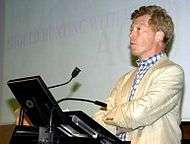
Roger Scruton
Roger Scruton, the British philosopher, argues that rights imply obligations. Every legal privilege, he writes, imposes a burden on the one who does not possess that privilege: that is, "your right may be my duty." Scruton therefore regards the emergence of the animal rights movement as "the strangest cultural shift within the liberal worldview", because the idea of rights and responsibilities is, he argues, distinctive to the human condition, and it makes no sense to spread them beyond our own species.[8]
He accuses animal rights advocates of "pre-scientific" anthropomorphism, attributing traits to animals that are, he says, Beatrix Potter-like, where "only man is vile." It is within this fiction that the appeal of animal rights lies, he argues. The world of animals is non-judgmental, filled with dogs who return our affection almost no matter what we do to them, and cats who pretend to be affectionate when, in fact, they care only about themselves. It is, he argues, a fantasy, a world of escape.[8]
Scruton singled out Peter Singer, a prominent Australian philosopher and animal-rights activist, for criticism. He wrote that Singer's works, including Animal Liberation, "contain little or no philosophical argument. They derive their radical moral conclusions from a vacuous utilitarianism that counts the pain and pleasure of all living things as equally significant and that ignores just about everything that has been said in our philosophical tradition about the real distinction between persons and animals."[8]
Tom Regan countered this view of rights by distinguishing moral agents and moral patients.[157]
Continuity between humans and nonhuman animals
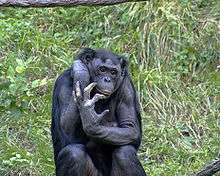
Evolutionary studies have provided explanations of altruistic behaviours in humans and nonhuman animals, and suggest similarities between humans and some nonhumans.[158] Scientists such as Jane Goodall and Richard Dawkins believe in the capacity of nonhuman great apes, humans' closest relatives, to possess rationality and self-awareness.[159]
In 2010, research was presented to a conference in San Diego, suggesting that dolphins are second in intelligence only to human beings, and concluded that they should be regarded as nonhuman persons. MRI scans were used to compare the dolphin and primate brain; the scans indicated there was "psychological continuity" between dolphins and humans. The research suggested that dolphins are able to solve complex problems, use tools, and pass the mirror test, using a mirror to inspect parts of their bodies.[160][161]
Studies have established links between interpersonal violence and animal cruelty.[162][163]
In Christian theology, the founder of the Methodist movement, John Wesley, was a Christian vegetarian and maintained "that animals had immortal souls and that there were considerable similarities between human and non-human animals."[164]
Public attitudes
According to a paper published in 2000 by Harold Herzog and Lorna Dorr, previous academic surveys of attitudes towards animal rights have tended to suffer from small sample sizes and non-representative groups.[165] However, a number of factors appear to correlate with the attitude of individuals regarding the treatment of animals and animal rights. These include gender, age, occupation, religion, and level of education. There has also been evidence to suggest that prior experience with companion animals may be a factor in people's attitudes.[166]
Women are more likely to empathize with the cause of animal rights than men.[166][167] A 1996 study suggested that factors that may partially explain this discrepancy include attitudes towards feminism and science, scientific literacy, and the presence of a greater emphasis on "nurturance or compassion" among women.[168]
A common misconception on the concept of animal rights is that its proponents want to grant non-human animals the exact same legal rights as humans, such as the right to vote. This is not the case, as the concept is that animals should have rights with equal consideration to their interests (for example, cats do not have any interest in voting, so they should not have the right to vote.)[169]
A 2016 study found that support for animal testing may not be based on cogent philosophical rationales, and more open debate is warranted.[170]
A 2007 survey to examine whether or not people who believed in evolution were more likely to support animal rights than creationists and believers in intelligent design found that this was largely the case – according to the researchers, the respondents who were strong Christian fundamentalists and believers in creationism were less likely to advocate for animal rights than those who were less fundamentalist in their beliefs. The findings extended previous research, such as a 1992 study which found that 48% of animal rights activists were atheists or agnostic.[171][172] A 2019 study in The Washington Post found that those who have positive attitudes toward animal rights also tend to have a positive view of universal healthcare, favor reducing discrimination against African Americans, the LGBT community and undocumented immigrants, and expanding welfare to aid the poor.[173]
Two surveys found that attitudes towards animal rights tactics, such as direct action, are very diverse within the animal rights communities. Near half (50% and 39% in two surveys) of activists do not support direct action. One survey concluded "it would be a mistake to portray animal rights activists as homogeneous."[166][174]
See also
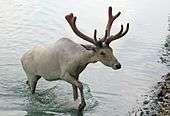
- Animal cognition
- Animal consciousness
- Animal liberation
- Animal liberation movement
- Animal liberationist
- Animal rights by country or territory
- Animal studies
- Animal trial
- Animal Welfare Institute
- Antinaturalism (politics)
- Cambridge Declaration on Consciousness
- Chick culling
- Critical animal studies
- Deep ecology
- Do Animals Have Rights? (book)
- List of songs about animal rights
- Plant rights
- Sentientism
- Timeline of animal welfare and rights
- Wild animal suffering
- World Animal Day
References
- Kumar, Satish (September 2002). "You are, therefore I am: A declaration of dependence".
- Taylor (2009), pp. 8, 19–20; Rowlands (1998), p. 31ff.
- "Animal Rights Law and Legal Definition | USLegal, Inc". definitions.uslegal.com. Retrieved 2019-11-07.
- Horta (2010).
- That a central goal of animal rights is to eliminate the property status of animals, see Sunstein (2004), p. 11ff.
- For speciesism and fundamental protections, see Waldau (2011).
- For food, clothing, research subjects or entertainment, see Francione (1995), p. 17.
- For animal law courses in North America, see "Animal law courses" Archived 2010-06-13 at the Wayback Machine, Animal Legal Defense Fund. Retrieved July 12, 2012.
- For a discussion of animals and personhood, see Wise (2000), pp. 4, 59, 248ff; Wise (2004); Posner (2004); Wise (2007).
- For the arguments and counter-arguments about awarding personhood only to great apes, see Garner (2005), p. 22.
- Also see Sunstein, Cass R. (February 20, 2000). "The Chimps' Day in Court", The New York Times.
- Giménez, Emiliano (January 4, 2015). "Argentine orangutan granted unprecedented legal rights". edition.cnn.com. CNN Espanol. Retrieved April 21, 2015.
- Scruton, Roger (Summer 2000). "Animal Rights". City Journal. New York: Manhattan Institute for Policy Research.
- Liguori, G.; et al. (2017). "Ethical Issues in the Use of Animal Models for Tissue Engineering: Reflections on Legal Aspects, Moral Theory, 3Rs Strategies, and Harm-Benefit Analysis" (PDF). Tissue Engineering Part C: Methods. 23 (12): 850–862. doi:10.1089/ten.TEC.2017.0189. PMID 28756735.
- Garner (2005), pp. 11, 16.
- Also see Frey (1980); and for a review of Frey, see Sprigge (1981).
- Singer (2000), pp. 151–156.
- Martin, Gus (15 June 2011). The SAGE Encyclopedia of Terrorism, Second Edition. SAGE. ISBN 9781412980166 – via Google Books.
- Sorabji (1993), p. 12ff.; Wise (2007).
- Francione (1995), p. 36.
- Rollin, Bernard E. (December 2010). Animal Rights and Human Morality. Prometheus Books. p. 117. ISBN 978-1-61592-211-6.
- Phelps, Norm (2002). Animal Rights According to the Bible. Lantern Books. p. 70. ISBN 978-1-59056-009-9.
The Bible's most important reference to the sentence and will of nonhuman animals is found in Deuteronomy 25:4, which became the scriptural foundation of the rabbinical doctrine of tsar ba'ale Chayim, "the suffering of the living," which makes relieving the suffering of animals a religious duty for Jews. "You shall not muzzle the ox while he is threshing." The point of muzzling the ox was to keep him from eating any of the grain that he was threshing. The point of the commandment was the cruelty of forcing an animal to work for hours at a time with his face only inches from delicious food while not allowing him to eat any of it. From time immemorial, Jew have taken great pride in the care they provide their animals.
- Steiner (2005), p. 47; Taylor (2009), p. 37.
- Taylor (2009), p. 37.
- Sorabji (1993) p. 45 ff.
- "Plutarch • Life of Cato the Elder". penelope.uchicago.edu.
- Beauchamp (2011a), pp. 4–5.
- Porphyry. On Abstinence from Animal Food Archived 2017-04-10 at the Wayback Machine, translated by Thomas Taylor, Animal Rights Library.
- Also see Clark (2011), pp. 37–38.
- The Statutes at Large. Dublin, 1786, cited in Ryder (2000), p. 49.
- Francione 1996, p. 7.
- Nash (1989), p. 19.
- Kete (2002), p. 19 ff.
- Midgley, Mary (May 24, 1999-2000).
- Honderich, Ted (1995). The Oxford Companion to Philosophy. Oxford University Press. pp. 188–192. ISBN 0198661320.
- Locke (1693).
- Waldau (2001), p. 9.
- Kant (1785), part II, paras 16 and 17.
- Rousseau (1754), quoted in Midgley (1984), p. 62.
- Bentham (1781), Part III.
- Benthall (2007), p. 1.
- Bentham (1789), quoted in Garner (2005), pp. 12—13.
- Legge and Brooman (1997), p. 40.
- Phelps (2007), pp. 96–98.
- Speeches in Parliament, of the Right Honourable William Windham. Volume I. Longman, Hurst, Rees, Orme, and Brown (1812), pp. 303, 340–356.
- Cruelty to Animals: The Speech of Lord Erskine in the House of Peers (London: Richard Phillips, 1809) p 2 Italics in original speech. Also see John Hostettler, Thomas Erskine and Trial By Jury (Hook, Hampshire: Waterside Press, 2010) pp 197-199. ISBN 978-1-904380-59-7
- Cruelty to Animals: The Speech of Lord Erskine, see the Preamble pp 6-7, other theological allusions pp 3, 8-9, 25 & 26
- Legge and Brooman (1997), p. 41.
- Phelps 2007, pp. 98–100.
- McCormick, John. Bullfighting: Art, Technique and Spanish Society. Transaction Publishers, 1999, p. 211.
- Legge and Brooman (1997), p. 50.
- "To Correspondents" The Kaleidoscope, 6 March 1821 p 288. Also see The Monthly Magazine Vol. 51 April 1, 1821 p 3."The Brute Species". "Notice" in Morning Post, 17 February 1821, p 3. Similarly see "Cruelty to Animals" The Sporting Magazine, Vol. VIII New Series No. XLIII (April 1821), p 33.
- See Kathryn Shevelow, For the Love of Animals: The Rise of the Animal Protection Movement (New York: Henry Holt, 2008), 268; Arthur W. Moss, Valiant Crusade: The History of the RSPCA (London: Cassell, 1961), 22.
- Anonymous (1972). "The History of the RSPCA", reproduced by the Animal Legal and Historical Center, Michigan State University College of Law. Retrieved March 25, 2008.
- Legge and Brooman 1997, p. 47.
- "The Legacy of Humanity Dick", Time magazine, January 26, 1970.
- Taylor (2009), p. 62.
- Nicholson, Edward.Rights of an Animal (1879), chapter 6.
- Nash 1989, p. 137.
- Schopenhauer, Arthur. On the Basis of Morality. This edition Hackett Publishing, 1998, p. 96.
- Phelps 2007, p. 153–154.
- Schopenhauer wrote in The Basis of Morality: "It is asserted that beasts have no rights ... that 'there are no duties to be fulfilled towards animals.' Such a view is one of revolting coarseness, a barbarism of the West, whose source is Judaism." A few passages later, he called the idea that animals exist for human benefit a "Jewish stence." See Phelps, op cit.
- Schopenhauer, Arthur. The World as Will and Idea Vol.I. The Project Gutenberg, 2011. p. 477.
- Schopenhauer, Arthur. Parerga & Paralipomena Vol. II. Cambridge University Press. pp. 144, 338.
- Beeton, Isabella; Andrews, Teresa (2019). Considering Chickens. ISBN 978-1089880066.
- Garner (2005), p. 12; Mill (1874) Archived 2012-08-05 at the Wayback Machine.
- Rachels (2009), pp. 124–126; Beauchamp (2009), pp. 248–249.
- Darwin (1837), quoted in Redclift (2010), p. 199.
- "Petition from Citizens of Ashtabula County, Ohio for a Constitutional Amendment that Representation in Congress be Uniform throughout the Country". National Archives Catalog. 1844. Retrieved July 29, 2016.
- "The ASPCA–Pioneers in Animal Welfare - Advocacy for Animals".
- Rudacille (2000), pp. 31, 46.
- Also see Vyvyan (1969).
- Ryder (2000), pp. 5–6.
- Animal Rights: A Historical Anthology. By Andrew Linzey, Paul A. B. Clarke
- The Selected Writings of Friedrich Nietzsche. ISBN 978-1-60459-332-7 Wilder Publications April 21, 2008.
- "Posthuman Destinies". sciy.org. Archived from the original on 2017-06-20. Retrieved 2012-09-15.
- Taylor (2009), p. 62.
- Salt 1894, chapter 1. Salt cited Spencer's definition of rights: "Every man is free to do that which he wills, provided he infringes not the equal liberty of any other man ... Whoever admits that each man must have a certain restricted freedom, asserts that it is right he should have this restricted freedom ... And hence the several particular freedoms deducible may fitly be called, as they commonly are called, his rights."
- Mason (1997).
- Lansbury (1985), pp. 152–169; Kean (1998), pp. 142–143.
- Salt (1880) Archived 2012-06-16 at the Wayback Machine, p. 7.
- Leneman (1999)
- Phelps (2007), pp. 163–165.
- Davis, John. "Gandhi—and the launching of veganism", International Vegetarian Union, March 16, 2011.
- "History of Vegetarianism: The Origin of Some Words", International Vegetarian Union, April 6, 2010.
- "Understanding Nazi Animal Protection and the Holocaust" (PDF). Anthrozoos: A Multidisciplinary Journal of The Interactions of People & Animals. 1992. doi:10.2752/089279392787011638.
- Sax (2000) p. 114.
- Proctor (1999), pp. 135–137; Sax (2000), pp. 35, 114.
- "Statistics of Scientific Procedures on Living Animals, Great Britain, 2005", Her Majesty's Stationery Office.
- "The Ethics of research involving animals" Archived June 25, 2008, at the Wayback Machine, Nuffield Council on Bioethics, section 1.6.
- "The history of the NAVS", National Anti-Vivisection Society.
- "Monument to the Little Brown Dog, Battersea Park" Archived December 6, 2008, at the Wayback Machine, Public Monument and Sculpture Association's National Recording Project.
- Singer (1990), p. 37, citing the US Congress Office of Technology Assessment's Alternatives to Animal Use in Research, Testing, and Education, 1986, p. 64.
- Ten billion animals are now killed for food every year in the US alone; see Williams and DeMello (2007), p. 73.
- Ryder (2000), p. 167ff.
- Garner (2004), p. 3ff.
- Waldau (2001), pp. 5, 23–29.
- Godlovitch, Godlovitch, and Harris (1971); see the Introduction for the reference to the symposium.
- Singer (April 5, 1973).
- Singer (1990), pp. xiv–xv.
- Also see "Food for Thought", letter from David Rosinger and reply from Peter Singer, The New York Review of Books, Volume 20, Number 10, June 14, 1973."Archived copy". Archived from the original on 2010-02-24. Retrieved 2008-03-26.CS1 maint: archived copy as title (link) CS1 maint: BOT: original-url status unknown (link)
- "동물권, 동물만 위하자는 게 아닙니다". KBS 뉴스 (in Korean). Retrieved 2020-05-06.
- Singer 1990, p. 5.
- Singer (1990), p. 269, footnote 4.
- Regan (2001), p. 67.
- Garner (2004), p. 2.
- Also see "A little respect for our friends", New Scientist, January 20, 1990.
- Molland (2004), pp. 70–74; Monaghan (2000), pp. 160–161.
- Best (2004), pp. 23–24.
- Singer (1998), pp. 151–152.
- Ben Gunn, former Chief Constable, Cambridge Constabulary, interviewed for "It Could Happen to You," True Spies, BBC Two, November 10, 2002.
- Rood, Justin. "Animal Rights Groups and Ecology Militants Make DHS Terrorist List, Right-Wing Vigilantes Omitted", Congressional Quarterly, March 25, 2005.
- Newkirk (2004), p. 341./
- Holder, T. (2014) - "Standing Up for Science", EMBO Reports, Volume 15, Issue 6, pages 625–630, June 2014
- Helton, Jesse J.; Staudenmeier, William J. (2002). "Re-imagining being 'straight' in straight edge". Contemporary Drug Problems. 29 (2): 465. doi:10.1177/009145090202900209. ISSN 0091-4509.CS1 maint: ref=harv (link)
- Wood, Robert T. (1999). "Nailed to the X: A Lyrical History of Straightedge". Journal of Youth Studies. 2 (2): 133–151. doi:10.1080/13676261.1999.10593032.CS1 maint: ref=harv (link)
- Tilbürger, Len; Kale, Chris P (2014). ""Nailing Descartes to the Wall": Animal Rights, Veganism and Punk Culture". Active Distribution.
- Kuhn, Gabriel (2010). Sober Living for the Revolution: Hardcore Punk, Straight Edge, and Radical Politics. PM Press. p. 137. ISBN 978-1604860511. Retrieved 7 October 2017.
- Francione and Garner (2010), p. 1ff.
- Feder, Barnaby J. (November 26, 1889). "Pressuring Perdue", The New York Times.
- Also see Singer (1998), and Singer (2003).
- Waldau (2011), p. 108.
- "Stopping Crush Videos". pet-abuse.com.
- Associated Press (January 15, 2008). "It's official: In Austria, a chimp is not a person". NBC News.
- Stinson, Jeffrey (July 15, 2008). "Activists pursue basic legal rights for great apes". USA Today.
- Albertsdottir, Ellen (February 5, 2010). "Dagens djurrätt" [Today's Animal Rights]. Sydskenskan (in Swedish). Archived from the original on February 7, 2010.
- Waldau (2011), p. 108
- McNeil, Donald G. (July 13, 2008). "When Human Rights Extend to Nonhumans". The New York Times.
- Roberts, Martin (June 25, 2008). "Spanish parliament to extend rights to apes". Reuters.
- Glendinning, Lee (July 18, 2008). "Spanish parliament approves 'human rights' for apes". The Guardian. Retrieved June 26, 2008.
- Singer, Peter (July 18, 2008). "Of great apes and men". The Guardian.
- "In Spain, Human rights for Apes". Time magazine. July 18, 2008.
- "IX Legislatura: Serie D: General 161/000099" [IX Legislature: Series D: General 161/000099]. Boletín Oficial de las Cortes Generales (in Catalan). Congreso de los Diputados. 23 May 2008. p. 22. Retrieved March 3, 2010.
- Kelch (2011), p. 216
- "Catalonia bans bullfighting in landmark Spain vote". BBC News. July 28, 2010.
- Perry, Tony (February 7, 2011). "PETA's bid to free SeaWorld orcas may not get far". Los Angeles Times.
- Associated Press (February 8, 2012). "California: Suit That Called Whales Slaves Is Dismissed". New York Times.
- "Press Release re. NhRP Lawsuit, Dec. 2nd 2013". The Nonhuman Rights Project. 2013-12-02. Archived from the original on December 22, 2015. Retrieved September 10, 2016.
- "Judge Recognizes Two Chimpanzees as Legal Persons, Grants them Writ of Habeas Corpus". The Nonhuman Rights Project. 2015-04-20. Archived from the original on September 9, 2016. Retrieved December 10, 2015.
- "That's One Small Step for a Judge, One Giant Leap for the Nonhuman Rights Project". The Nonhuman Rights Project. 2015-08-04. Archived from the original on May 12, 2016. Retrieved December 11, 2015.
- Garner (2005), pp. 21–22.
- Watanabe, Zenjiro. "Removal of the Ban on Meat: The Meat-Eating Culture of Japan at the Beginning of Westernization" (PDF). Retrieved 2020-04-26.
- "Govt bans use of live animals for education, research". The Times of India.
- van Popering, Ruben (2015). Jain Vegetarian Laws in the City of Palitana : Indefensible Legal Enforcement or Praiseworthy Progressive Moralism?. Linköping University, Department of Culture and Communication, Centre for Applied Ethics.
- Garner (2005), pp. 21–22.
- Grant, Catharine (2006). The No-nonsense Guide to Animal Rights. New Internationalist. p. 24. ISBN 9781904456407.
These religions emphasize ahimsa, which is the principle of non-violence towards all living things. The first precept is a prohibition against the killing of any creature. The Jain, Hindu and Buddhist injunctions against killing serve to teach that all creatures are spiritually equal.
- "BBC - Religions - Islam: Animals". bbc.co.uk.
- Craig (1988).
- Nussbaum (2006), pp. 388ff, 393ff; also see Nussbaum (2004), p. 299ff.
- Weir (2009): see Clark (1977); Rollin (1981); Midgley (1984).
- Vallentyne (2005); Vallentyne (2007).
- Rowlands (2009), p. 98ff; Hursthouse (2000a); Hursthouse (2000b), p. 146ff.
- Rowlands (1998), p. 118ff, particularly pp. 147–152.
- Nussbaum (2004), p. 302.
- For a discussion of preference utilitarianism, see Singer (2011), pp. 14ff, 94ff.
- Singer (1990), pp. 7–8.
- Singer (1990), p. 4.
- Rollin (1989), pp. xii, pp. 117–118; Rollin (2007).
- Singer (1990), pp. 10–17, citing Stamp Dawkins (1980), Walker (1983), and Griffin (1984); Garner (2005), pp. 13–14.
- Singer (1990) p. 12ff.
- Regan (1983), p. 243.
- Regan (1983).
- Francione (1990), pp. 4, 17ff.
- Francione (1995), pp. 4–5.
- Francione (1995), p. 208ff.
- Francione (1996), p. 32ff
- Francione and Garner (2010), pp. 1ff, 175ff.
- Hall, Lee. "An Interview with Professor Gary L. Francione" Archived May 8, 2009, at the Wayback Machine, Friends of Animals. Retrieved February 3, 2011.
- Hinman, Lawrence M. Ethics: A Pluralistic Approach to Moral Theory. Fort Worth, TX: Harcourt Brace College, 1998. Print.
- Garry, Timothy J. Nonhuman Animals: Possessors of Prima Facie Rights (2012), p.6
- Lansbury (1985); Adams (1990); Donovan (1993); Gruen (1993); Adams (1994); Adams and Donovan (1995); Adams (2004); MacKinnon (2004).
- Kean (1995).
- Garner (2005), p. 141, citing Elston (1990), p. 276.
- Garner (2005), pp. 142–143.
- Gruen (1993), p. 60ff.
- Singer (1990), p. 1.
- George Dvorsky. "The Ethics of Animal Enhancement".
- Evans, Woody (2015). "Posthuman Rights: Dimensions of Transhuman Worlds". Teknokultura. 12 (2). doi:10.5209/rev_TK.2015.v12.n2.49072.
- Frey (1989), p. 40.
- pg. 94-100. Cohen and Regan (2001).
- Posner (June 15, 2001); Posner-Singer debate in full, courtesy link on utilitarian.net.
- Also see Posner (2004).
- Singer (June 15, 2001).
- Tom Regan: The Case For Animal Rights. The VegetarianSite. Accessed November 2, 2019
- Lawrence (2004) Animal Acts: Configuring the Human in Western History. Journal of Popular Culture, 37(3), 555
- The Great Ape Project: Equality beyond humanity. 1993. Fourth Estate publishing, London, England.
- Reiss, D. (2011). "Dolphin Research: Educating the Public". Science. 332 (6037): 1501. Bibcode:2011Sci...332.1501R. doi:10.1126/science.332.6037.1501-b. PMID 21700853.
- Leake, Jonathan (January 3, 2010). "Scientists say dolphins should be treated as 'non-human persons'", The Sunday Times.
- Frank R. Ascione, Phil Arkow Child abuse, domestic violence, and animal abuse: linking the circles of compassion for prevention and intervention ISBN 1-55753-142-0
- Randall Lockwood, Frank R. Ascione. Cruelty to Animals and Interpersonal Violence. Purdue University Press 1998
- Preece, Rod (1 July 2009). Sins of the Flesh: A History of Ethical Vegetarian Thought. UBC Press. p. 239. ISBN 9780774858496.
- Herzog, Harold; Dorr, Lorna (2000). "Electronically Available Surveys of Attitudes Toward Animals". Society & Animals. 10 (2).
- Apostol, L.; Rebega, O.L.; Miclea, M. (2013). "Psychological and Socio-Demographic Predictors of Attitudes towards Animals". Social and Behavioural Sciences (78): 521–525.
- Herzog, Harold (2007). "Gender Differences in Human-Animal Interactions: A Review". Anthrozoos: A Multidisciplinary Journal of The Interactions of People & Animals. 20 (1): 7–21.
- Pifer, Linda (1996). "Exploring the Gender Gap in Young Adults' Attitudes about Animal Research". Society and Animals. 4 (1): 37–52.
- "Ethics - Animal ethics: Animal rights". BBC. Retrieved November 9, 2019.
- Joffe, Ari R.; Bara, Meredith; Anton, Natalie; Nobis, Nathan (March 29, 2016). "The ethics of animal research: a survey of the public and scientists in North America". BMC Medical Ethics. 17: 17. doi:10.1186/s12910-016-0100-x. ISSN 1472-6939. PMC 4812627. PMID 27025215.
- DeLeeuwa, Jamie; Galen, Luke; Aebersold, Cassandra; Stanton, Victoria (2007). "Support for Animal Rights as a Function of Belief in Evolution, Religious Fundamentalism, and Religious Denomination" (PDF). Society and Animals (15): 353–363. Archived from the original (PDF) on June 20, 2013.
- Galvin, Shelley L.; Herzog Jr., Harold A. (1992). "Ethical Ideology, Animal Rights Activism, And Attitudes Toward The Treatment Of Animals". Ethics & Behavior. 2 (3): 141–149.
- Park, Yon Soo; Valentino, Benjamin (July 26, 2019). "Who supports animal rights? Here's what we found". The Washington Post. Retrieved July 26, 2019.
- "An attitude survey of animal rights activists". Psychological Science. 2 (3): 194–196.
Bibliography
- Books and papers are cited in short form in the footnotes, with full citations here. News and other sources are cited in full in the footnotes.
- Adams, Carol J. (1996). The Sexual Politics of Meat: A Feminist-Vegetarian Critical Theory. Continuum. ISBN 1501312839
- Adams, Carol J.; Donovan, Josephine, eds. (1995). Animals and Women: Feminist Theoretical Explorations. Duke University Press. ISBN 0822316552
- Adams, Carol J. (2004). The Pornography of Meat. Continuum. ISBN 9781590565100
- Benthall, Jonathan (2007). "Animal liberation and rights", Anthropology Today, volume 23, issue 2, April.
- Bentham, Jeremy (1781). Principles of Penal Law. ISBN 1379912326
- Beauchamp, Tom (2009). "The Moral Standing of Animals", in Marc Bekoff. Encyclopedia of Animal Rights and Animal Welfare. Greenwood. ISBN 0313352593
- Beauchamp, Tom (2011a). "Introduction," in Tom Beauchamp and R.G. Frey (eds.). The Oxford Handbook of Animal Ethics. Oxford University Press. ISBN 019935197X
- Beauchamp, Tom (2011b). "Rights Theory and Animal Rights," in Beauchamp and Frey, op cit. ISBN 019935197X
- Clark, Stephen R. L. (1977). The Moral Status of Animals. Oxford University Press. ISBN 0192830406
- Cohen, Carl (1986). "The Case for the Use of Animals in Biomedical Research", New England Journal of Medicine, vol. 315, issue 14, October, pp. 865–870.
- Cohen, Carl and Regan, Tom (2001). The Animal Rights Debate. Rowman & Littlefield. ISBN 0847696626
- Craig, Edward (ed.) (1988). "Deontological Ethics" and "Consequentalism," Routledge Encyclopedia of Philosophy.
- Donovan, Josephine (1993). "Animal Rights and Feminist Theory," in Greta Gaard. Ecofeminism: Women, Animals, Nature. Temple University Press.
- Francione, Gary (1996). Rain Without Thunder: The Ideology of the Animal Rights Movement. Temple University Press.
- Francione, Gary (1995). Animals, Property, and the Law. Temple University Press.
- Francione, Gary (2008). Animals as Persons. Columbia University Press.
- Francione, Gary and Garner, Robert (2010). The Animal Rights Debate: Abolition Or Regulation?. Columbia University Press.
- Fellenz, Mark R. (2007). The Moral Menagerie: Philosophy and Animal Rights. University of Illinois Press.
- Frey, R.G. (1980). Interests and Rights: The Case against Animals. Clarendon Press.
- Frey, R.G. (1989). "Why Animals Lack Beliefs and Desires," in Peter Singer and Tom Regan (eds.). Animal Rights and Human Obligations. Prentice Hall.
- Garner, Robert (2004). Animals, Politics and Morality. Manchester University Press.
- Garner, Robert (2005). The Political Theory of Animals Rights. Manchester University Press.
- Giannelli, Michael A. (1985). "Three Blind Mice, See How They Run: A Critique of Behavioral Research With Animals". In M.W. Fox & L.D. Mickley (Eds.), Advances in Animal Welfare Science 1985/1986 (pp. 109-164). Washington, DC: The Humane Society of the United States
- Gruen, Lori (1993). "Dismantling Oppression: An Analysis of the Connection Between Women and Animals", in Greta Gaard. Ecofeminism: Women, Animals, Nature. Temple University Press.
- Griffin, Donald (1984). Animal Thinking. Harvard University Press.
- Godlovitch, Roslind; Godlovitch Stanley; and Harris John (1971). Animals, Men and Morals: An Inquiry into the Maltreatment of Non-humans. Victor Gollancz.
- Horta, Oscar (2010). "What Is Speciesism?", The Journal of Environmental and Agricultural Ethics, Vol. 23, No. 3, June, pp. 243–266.
- Hursthouse, Rosalind (2000a). On Virtue Ethics. Oxford University Press.
- Hursthouse, Rosalind (2000b). Ethics, Humans and Other Animals. Routledge.
- Kant, Immanuel (1785). Groundwork of the Metaphysic of Morals.
- Kean, Hilda (1998). Animal Rights: Political and Social Change in Britain since 1800. Reaktion Books.
- Kean, Hilda (1995). "The 'Smooth Cool Men of Science': The Feminist and Socialist Response to Vivisection", History Workshop Journal, No. 40 (Autumn), pp. 16–38.
- Kelch, Thomas G. (2011). Globalization and Animal Law. Kluwer Law International.
- Kete, Kathleen (2002). "Animals and Ideology: The Politics of Animal Protection in Europe," in Nigel Rothfels (ed.). Representing Animals. Indiana University Press.
- Lansbury, Coral (1985). The Old Brown Dog: Women, Workers, and Vivisection in Edwardian England. University of Wisconsin Press.
- Legge, Debbi and Brooman, Simon (1997). Law Relating to Animals. Cavendish Publishing. ISBN 1859412386
- Leneman, Leah (1999). "No Animal Food: The Road to Veganism in Britain, 1909–1944," Society and Animals, 7, 1–5.
- Locke, John (1693). Some Thoughts Concerning Education.
- MacKinnon, Catharine A. (2004). "Of Mice and Men," in Nussbaum and Sunstein, op cit.
- Mason, Peter (1997). The Brown Dog Affair. Two Sevens Publishing.
- Midgley, Mary (1984). Animals and Why They Matter. University of Georgia Press. ISBN 0820320412
- Molland, Neil (2004). "Thirty Years of Direct Action" in Best and Nocella, op cit.
- Monaghan, Rachael (2000). "Terrorism in the Name of Animal Rights," in Taylor, Maxwell and Horgan, John. The Future of Terrorism. Routledge.
- Murray, L. (2006). "The ASPCA–Pioneers in Animal Welfare", Encyclopædia Britannica's Advocacy for Animals.
- Najafi, Sina and Kete, Kathleen (2001). "Beastly Agendas: An Interview with Kathleen Kete", Cabinet, issue 4, Fall.
- Nash, Roderick (1989). The Rights of Nature: A History of Environmental Ethics. University of Wisconsin Press.
- Newkirk, Ingrid (2004). "The ALF: Who, Why, and What?", in Steven Best and Anthony Nocella. (eds).Terrorists or Freedom Fighters? Reflections on the Liberation of Animals. Lantern 2004.
- Nussbaum, Martha (2004). "Beyond Compassion and Humanity: Justice for Nonhuman Animals", in Cass Sunstein and Martha Nussbaum (eds.). Animal Rights: Current Debates and New Directions. Oxford University Press.
- Nussbaum, Martha (2006). Frontiers of Justice: Disability, Nationality, Species Membership. Belknap Press.
- Phelps, Norm (2007). The Longest Struggle: Animal Advocacy from Pythagoras to PETA. Lantern Books.
- Posner, Richard and Singer, Peter (June 15, 2001). Posner-Singer debate, Slate.
- Posner, Richard and Singer, Peter (2004). "Animal rights" in Sunstein and Nussbaum, op cit.
- Proctor, Robert N. (1999). The Nazi War on Cancer. Princeton University Press.
- Rachels, James (2009). "Darwin, Charles," in Bekoff, op cit.
- Redclift, Michael R. (2010). The International Handbook of Environmental Sociology. Edward Elgar Publishing.
- Regan, Tom (1983). The Case for Animal Rights. University of California Press.
- Regan, Tom (2001). Defending Animal Rights. University of Illinois Press.
- Rollin, Bernard (1981). Animal Rights and Human Morality. Prometheus Books.
- Rollin, Bernard (1989). The Unheeded Cry: Animal Consciousness, Animal Pain, and Science. New York: Oxford University Press.
- Rollin, Bernard (2007). "Animal research: a moral science", Nature, EMBO Reports 8, 6, pp. 521–525.
- Rousseau, Jean-Jacques (1754). Discourse on Inequality.
- Rowlands, Mark (2009) [1998]. Animal Rights. A Defense. Palgrave Macmillan.
- Rudacille, Deborah (2000). The Scalpel and the Butterfly. University of California Press.
- Ryder, Richard (2000) [1989]. Animal Revolution: Changing Attitudes Towards Speciesism. Berg.
- Salt, Henry Stephens (1880). A Plea for Vegetarianism and other essays.
- Salt, Henry Stephens (1894). Animals' Rights: Considered in Relation to Social Progress, Macmillan & Co.
- Salt, Henry Stephens (1899). The logic of vegetarianism
- Sapontzis, Steve (1985). "Moral Community and Animal Rights", American Philosophical Quarterly, Vol. 22, No. 3 (July), pp. 251–257.
- Sax, Boria (2000). Animals in the Third Reich: Pets, Scapegoats, and the Holocaust. Continuum International Publishing Group.
- Scruton, Roger (1998). Animal Rights and Wrongs. Claridge Press.
- Scruton, Roger (2000). "Animal Rights", City Journal, summer.
- Singer, Peter (April 5, 1973). "Animal liberation", The New York Review of Books, Volume 20, Number 5.
- Singer, Peter (1990) [1975]. Animal Liberation. New York Review Books.
- Singer, Peter (2000) [1998]. Ethics into Action: Henry Spira and the Animal Rights Movement. Rowman and Littlefield Publishers, Inc.
- Singer, Peter (2003). "Animal liberation at 30", The New York Review of Books, vol 50, no. 8, May 15.
- Singer, Peter (2004). "Ethics Beyond Species and Beyond Instincts," in Sunstein and Nussbaum, op cit.
- Singer, Peter (2011) [1979]. Practical Ethics. Cambridge University Press.
- Sorabji, Richard (1993). Animal Minds and Human Morals. University of Cornell Press.
- Sprigge, T.L.S. (1981) "Interests and Rights: The Case against Animals", Journal of Medical Ethics. June, 7(2): 95–102.
- Stamp Dawkins, Marian (1980). Animal Suffering: The Science of Animal Welfare. Chapman and Hall.
- Steiner, Gary (2005). Anthropocentrism and its Discontents: The Moral Status of Animals in the History of Western Philosophy. University of Pittsburgh Press.
- Sunstein, Cass R. (2004). "Introduction: What are Animal Rights?" in Sunstein and Nussbaum, op cit.
- Sunstein, Cass R. and Nussbaum, Martha (2005). Animal Rights: Current Debates and New Directions. Oxford University Press. ISBN 0195305108
- Taylor, Angus (2009). Animals and Ethics: An Overview of the Philosophical Debate. Broadview Press.
- Taylor, Thomas (1792). "A Vindication of the Rights of Brutes," in Craciun, Adriana (2002). A Routledge Literary Sourcebook on Mary Wollstonecraft's A Vindication of the Rights of Woman. Routledge.
- Uekoetter, Frank (2006). The Green and the Brown: A History of Conservation in Nazi Germany. Cambridge University Press.
- Vallentyne, Peter (2005). "Of Mice and Men: Equality and Animals", The Journal of Ethics, Vol. 9, No. 3/4, pp. 403–433.
- Vallentyne, Peter (2007). "Of Mice and Men: Equality and Animals" in Nils Holtug, and Kasper Lippert-Rasmussen (eds.) (2007). Egalitarianism: New Essays on the Nature and Value of Equality. Oxford University Press.
- Vyvyan, John. (1969). In Pity and in Anger. M. Joseph.
- Waldau, Paul (2001). The Specter of Speciesism: Buddhist and Christian Views of Animals. Oxford University Press.
- Waldau, Paul (2011). Animal Rights: What Everyone Needs to Know. Oxford University Press.
- Walker, Stephen (1983). Animal Thoughts. Routledge.
- Ward, Nathaniel (1896). The Earliest New England Code of Laws, 1641. A. Lovell & Company.
- Weir, Jack (2009). "Virtue Ethics," in Marc Bekoff. Encyclopedia of Animal Rights and Animal Welfare. Greenwood. ISBN 0313352593
- Williams, Erin E. and DeMello, Margo (2007). Why Animals Matter. Prometheus Books.
- Wise, Steven M. (2000). Rattling the Cage: Toward Legal Rights for Animals. Da Capo Press.
- Wise, Steven M. (2002). Drawing the Line: Science and the Case for Animal Rights. Perseus.
- Wise, Steven M. (2004). "Animal Rights, One Step at a Time," in Sunstein and Nussbaum, op cit.
- Wise, Steven M. (2007). "Animal Rights", Encyclopædia Britannica.
Further reading
| Wikiquote has quotations related to: Animal rights |
- Lubinski, Joseph (2002). "Overview Summary of Animal Rights", The Animal Legal and Historical Center at Michigan State University College of Law.
- "Great Apes and the Law", The Animal Legal and Historical Center at Michigan State University College of Law.
- Bekoff, Marc (ed.) (2009). The Encyclopedia of Animal Rights and Animal Welfare. Greenwood.
- Best, Steven and Nocella II, Anthony J. (eds). (2004). Terrorists or Freedom Fighters? Reflections on the Liberation of Animals. Lantern Books
- Chapouthier, Georges and Nouët, Jean-Claude (eds.) (1998). The Universal Declaration of Animal Rights. Ligue Française des Droits de l'Animal.
- Dawkins, Richard (1993). Gaps in the mind, in Cavalieri, Paola and Singer, Peter (eds.). The Great Ape Project. St. Martin's Griffin.
- Dombrowski, Daniel (1997). Babies and Beasts: The Argument from Marginal Cases. University of Illinois Press.
- Foltz, Richard (2006). Animals in Islamic Tradition and Muslim Cultures. Oneworld Publications.
- Franklin, Julian H. (2005). Animal Rights and Moral Philosophy. University of Columbia Press.
- Gruen, Lori (2003). "The Moral Status of Animals", Stanford Encyclopedia of Philosophy, July 1, 2003.
- _________ (2011). Ethics and Animals. Cambridge University Press.
- Hall, Lee (2006). Capers in the Churchyard: Animal Rights Advocacy in the Age of Terror. Nectar Bat Press.
- Linzey, Andrew and Clarke, Paul A. B.(eds.) (1990). Animal Rights: A Historic Anthology. Columbia University Press.
- ___________ (ed.) (forthcoming). Animal Encyclopedia. University of Princeton Press.
- ___________ (ed.) (forthcoming). The Global Guide to Animal Protection. University of Illinois Press.
- Mann, Keith (2007). From Dusk 'til Dawn: An Insider's View of the Growth of the Animal Liberation Movement. Puppy Pincher Press.
- Neumann, Jean-Marc (2012). "The Universal Declaration of Animal Rights or the Creation of a New Equilibrium between Species". Animal Law Review volume 19-1.
- Nibert, David (2002). Animal Rights, Human Rights: Entanglements of Oppression and Liberation. Rowman and Litterfield.
- Patterson, Charles (2002). Eternal Treblinka: Our Treatment of Animals and the Holocaust. Lantern.
- Rachels, James (1990). Created from Animals: The Moral Implications of Darwinism. Oxford University Press.
- Regan, Tom and Singer, Peter (eds.) (1976). Animal Rights and Human Obligations. Prentice-Hall.
- Spiegel, Marjorie (1996). The Dreaded Comparison: Human and Animal Slavery. Mirror Books.
- Sztybel, David (2006). "Can the Treatment of Animals Be Compared to the Holocaust?" Ethics and the Environment 11 (Spring): 97–132.
- Tobias, Michael (2000). Life Force: The World of Jainism. Asian Humanities Press.
- Wilson, Scott (2010). "Animals and Ethics" Internet Encyclopedia of Philosophy.
- Yunt, Jeremy D. (2004). "Shock the Monkey: Confessions of a Rational Animal Liberationist," Philosophy Now, Issue 44 (Jan./Feb.).
- Yunt, Jeremy D. (2017). Faithful to Nature: Paul Tillich and the Spiritual Roots of Environmental Ethics. Barred Owl Books.
- Yunt, Jeremy D. (2019). Suffering, Empathy, and Ecstasy: Animal Liberation as the Furthest Reaches of Our Moral Evolution. Barred Owl Books.
